Southeast-facing windows are a great way to grow all the sun-loving plants you have had your eyes on. They offer plenty of sunlight all day.
Most of these plants have a pretty manageable care routine and rarely cause problems.
All you need to do is know exactly which species can tolerate the sun well and what other conditions are needed for them to flourish fully.
30 Houseplants for Southeast-Facing Window
- Aloe Vera
- Jade Plant
- Garden Croton
- Hibiscus
- Dwarf Citrus
- String of Pearls
- African Milk Bush
- Ponytail Palm
- Areca Palm
- Jasmine
- Geranium
- Sweet Basil
- Sago Palm
- Money Palm
- Bird of Paradise
- String of Hearts
- Citrus Trees
- Lavender
- Kalanchoe
- Dracaena Fragrans
- Anthurium
- Fiddle Leaf Fig
- Ficus Audrey
- Pencil Cactus
- Prayer Plants
- Umbrella Tree
- Goldfish Plant
- Paddle Plant
- Lady Palm
- Bulb Albuca Namaquensis
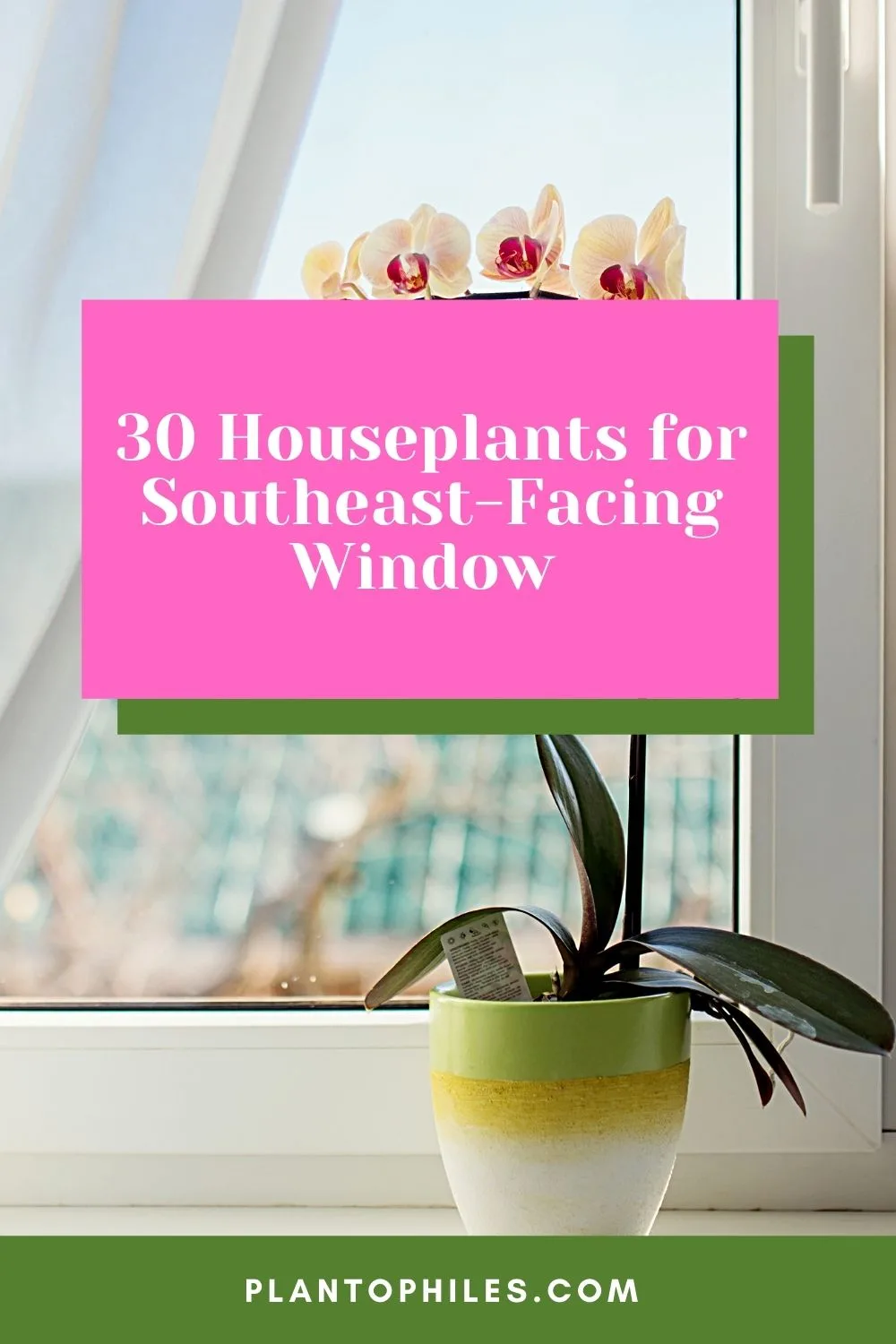
30 Houseplants for Southeast-Facing Windows
Best Houseplants for Southeast-Facing Window
1. Aloe Vera
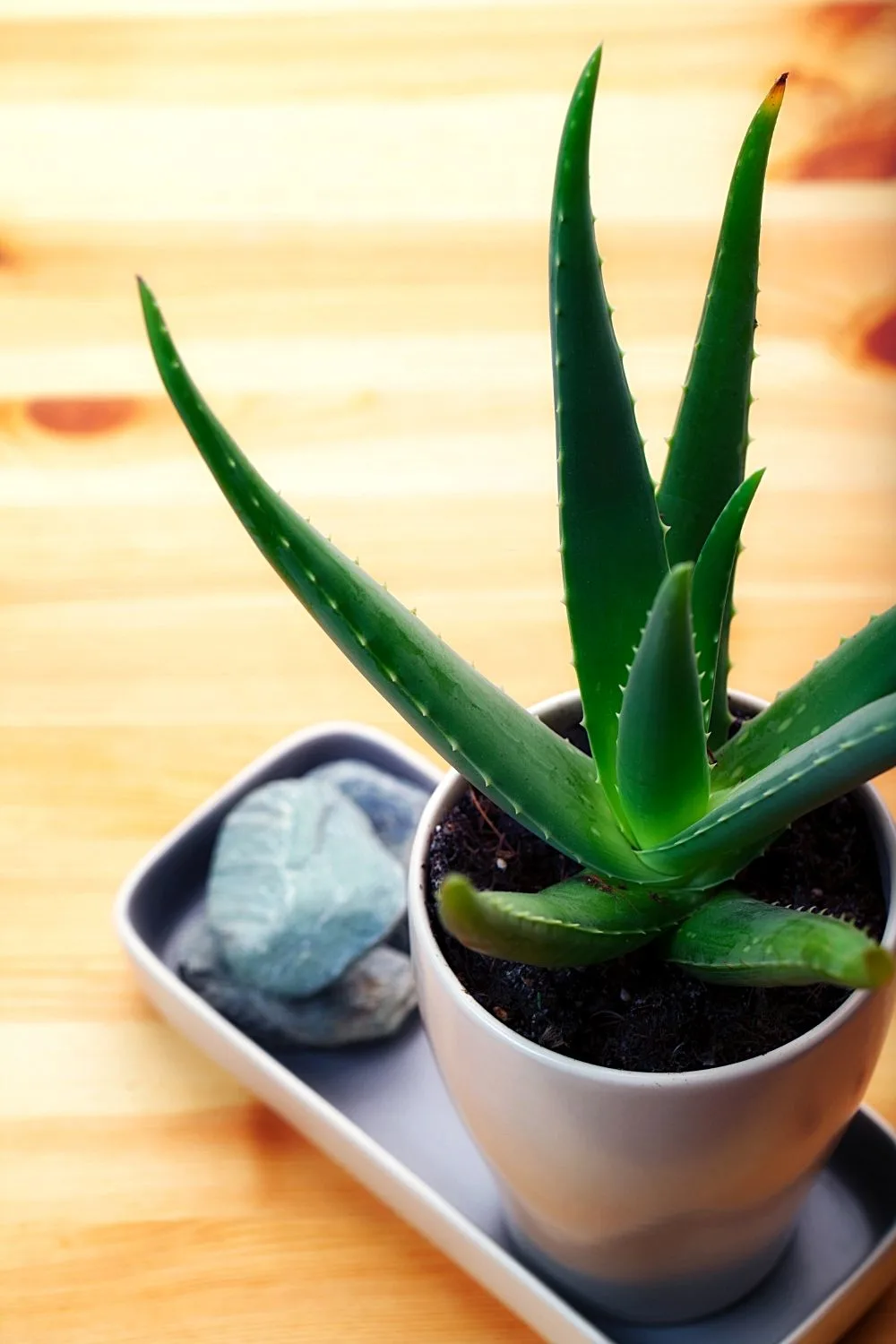
Aloe Vera is a great herbal plant that you can grow on your southeast-facing window
One of the most popular plants worldwide is Aloe vera. Apart from producing a highly beneficial dermal ingredient, the aloe vera plant is also easy to grow, fragrant, and has numerous medicinal uses.
A healthy plant’s leaves are usually fleshy, thick, and softly serrated.
A native of the tropical and arid Arabian Peninsula regions, aloe vera needs moderate to high light levels to survive. Place the plant in at least six hours of sunlight every day so that it grows fresh and healthy.
However, don’t leave it there for too long as the foliage may scorch.
Southeast-facing windows are ideal for the aloe plant as they offer maximum sunlight. Please do consider rotating the plant every few days to prevent foliage damage.
- Scientific name: Aloe barbadensis miller
- Light requirements: moderate to high
- Watering requirements: low to moderate
- Growth rate: moderate
- Temperature: 55 to 80 degrees Fahrenheit
- pH: 7 to 8.5
- Care: moderate
2. Jade Plant
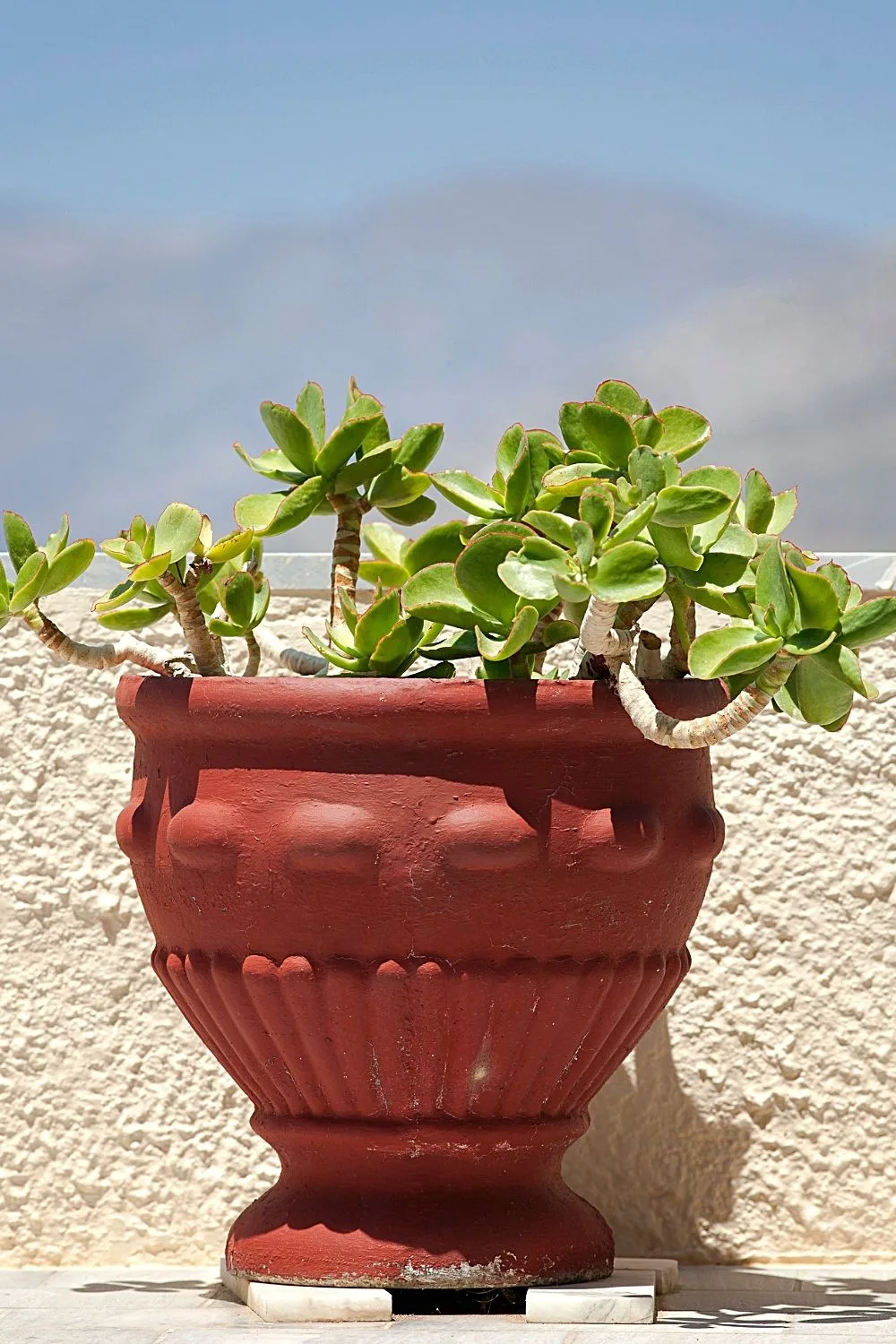
Jade Plant is a classic plant that you can grow on a southeast-facing window as it has a manageable care routine
Perhaps no list is complete without the jade plant. Popular for its classic look and manageable care routine, this flora loves plenty of sunlight.
It has many names, including Lucky plant and Money tree. The overall appearance of these various types is same-dark green succulent leaves with small flowers colored pink or white.
Naturally, the jade plant is found in Mozambique and South Africa; this is why the plant is used to such high light levels.
The ideal spot for this beauty indoors is southeast-facing windows; however, please partially block the light to prevent over-heating.
- Scientific name: Crassula ovata
- Light requirements: moderate to high
- Watering requirements: low to moderate
- Growth rate: moderate
- Temperature: 65 to 75 degrees Fahrenheit
- pH: 6 to 7
- Care: low to moderate
3. Garden Croton
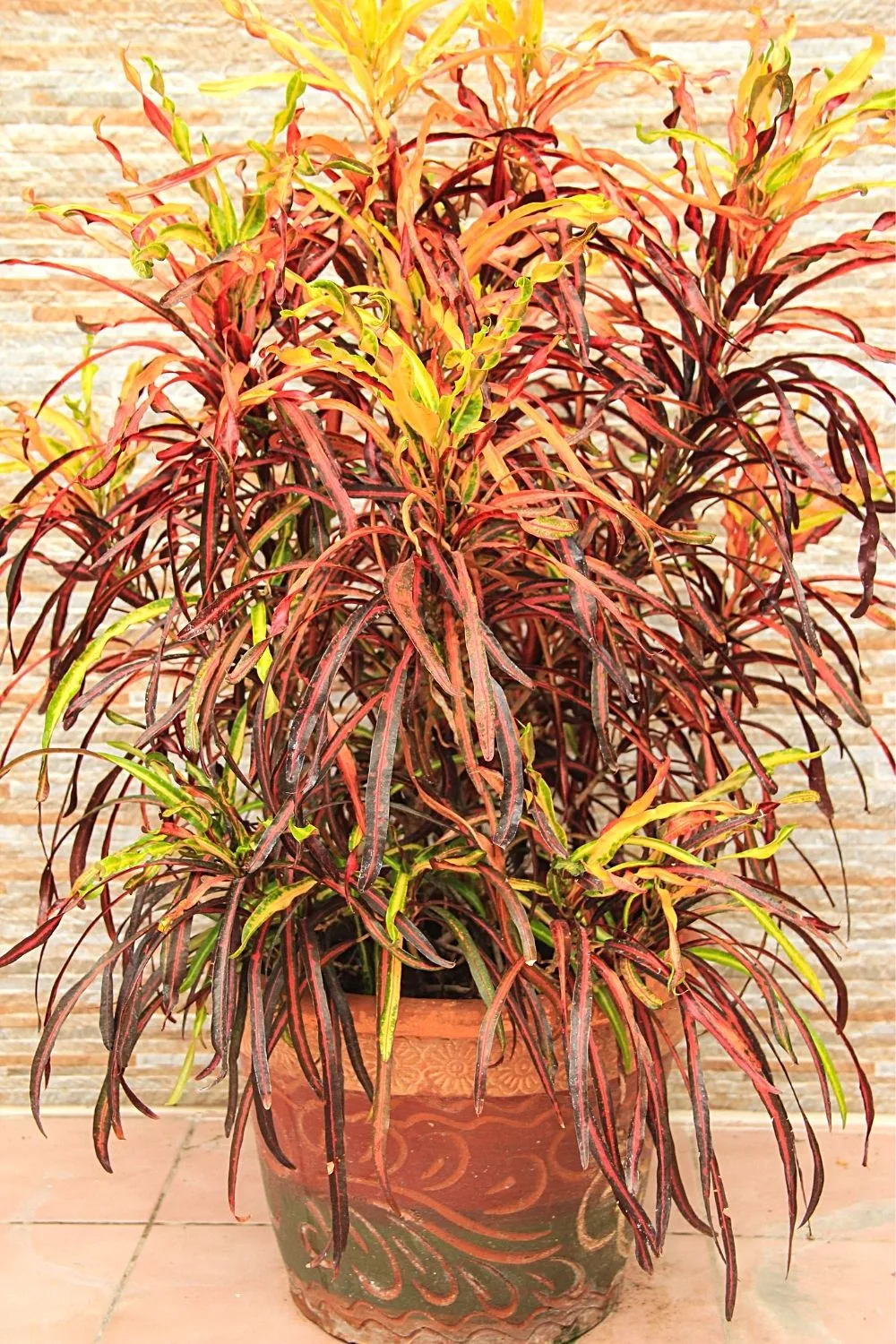
Despite the “garden” in the name, you can grow Garden Croton indoors by a southeast-facing window
A lovely addition to your houseplants will be garden croton due to its pretty foliage. Despite the ‘garden’ name, this plant makes an excellent indoor plant.
Sometimes referred to as Variegated Laurel, garden croton is exotic, to say the least.
Garden Croton comes in great color variety, such as yellow, red, copper, pink, and orange. These tropical Euphorbias grow best under the full sun.
The leaves’ vibrancy primarily depends on the amount of sunlight; the more the better.
However, please do remember to not leave them in the sun for too long, as the leaves will eventually burn if the light is too harsh.
- Scientific name: Codiaeum variegatum
- Light requirements: moderate to high
- Watering requirements: low to moderate
- Growth rate: moderate
- Temperature: 65 to 95 degrees Fahrenheit
- pH: 4.5 to 6.5
- Care: low to moderate
4. Hibiscus
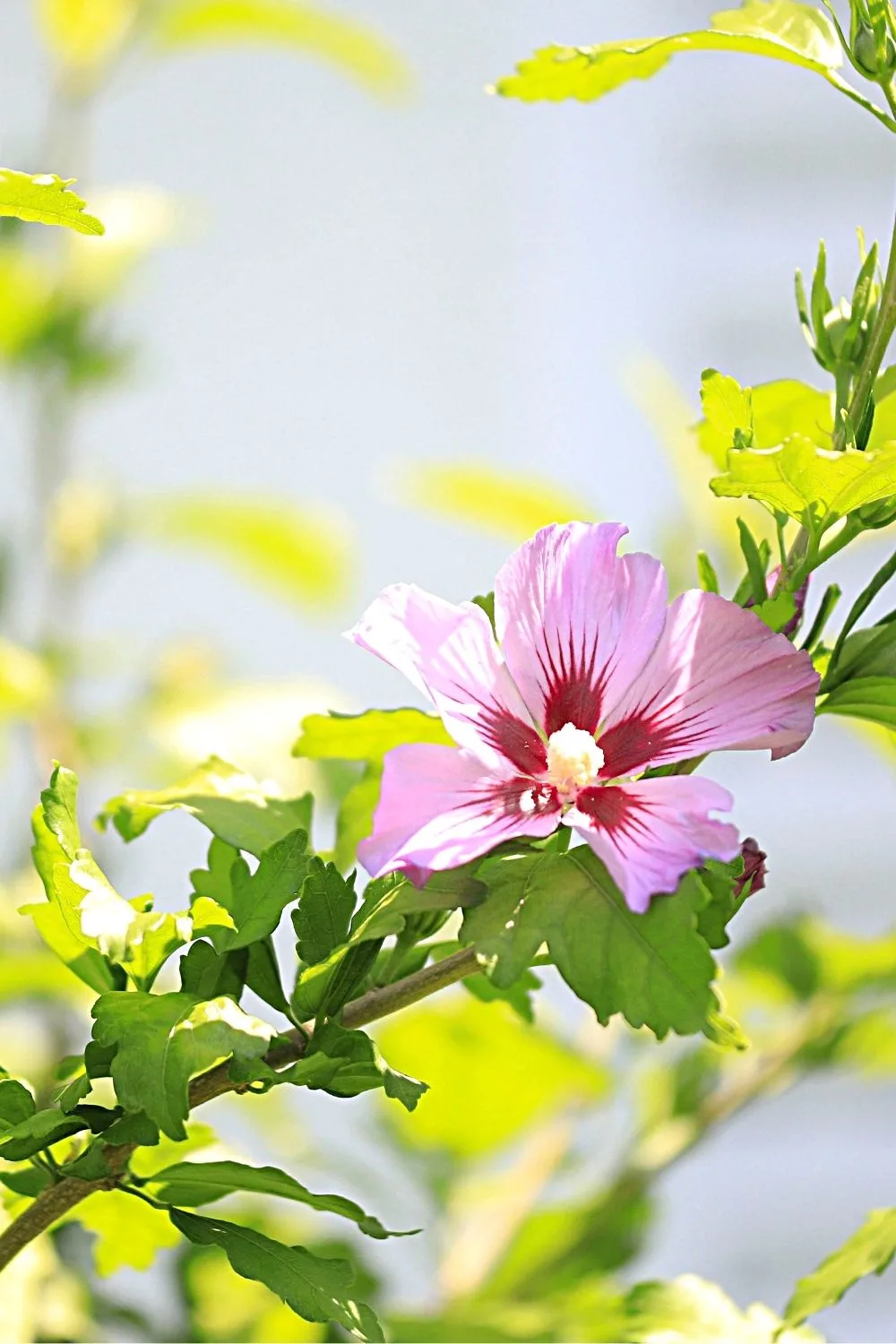
If you’re a tropical plant lover, grow Hibiscus by your southeast-facing window
The hibiscus is a well-known Hawaiian plant found in most tropical plant lovers’ houses. The hibiscus plant thoroughly enjoys bright, dappled sunlight for at least six hours a day.
Though it doesn’t cause a lot of trouble, hibiscus may be slightly finicky indoors.
It belongs to the Malvaceae family, also called the mallow family. These plants are particular about their needs, which include ample sunlight, frequent watering, and fertile, light soils.
But they do reward the grower for their extensive care with their lovely vibrancy and decadent flowers.
The flowers on a hibiscus are short-lived though. A hibiscus flower only lasts about 1 day according to the University of Minnesota.
Place the hibiscus in the sunniest southeast-facing window in your house for the healthiest plant.
- Scientific name: Hibiscus rosa-sinensis
- Light requirements: moderate to high
- Watering requirements: low to moderate
- Growth rate: moderate
- Temperature: 60 to 85 degrees Fahrenheit
- pH: 6.5 to 6.8
- Care: low to moderate
5. Dwarf Citrus
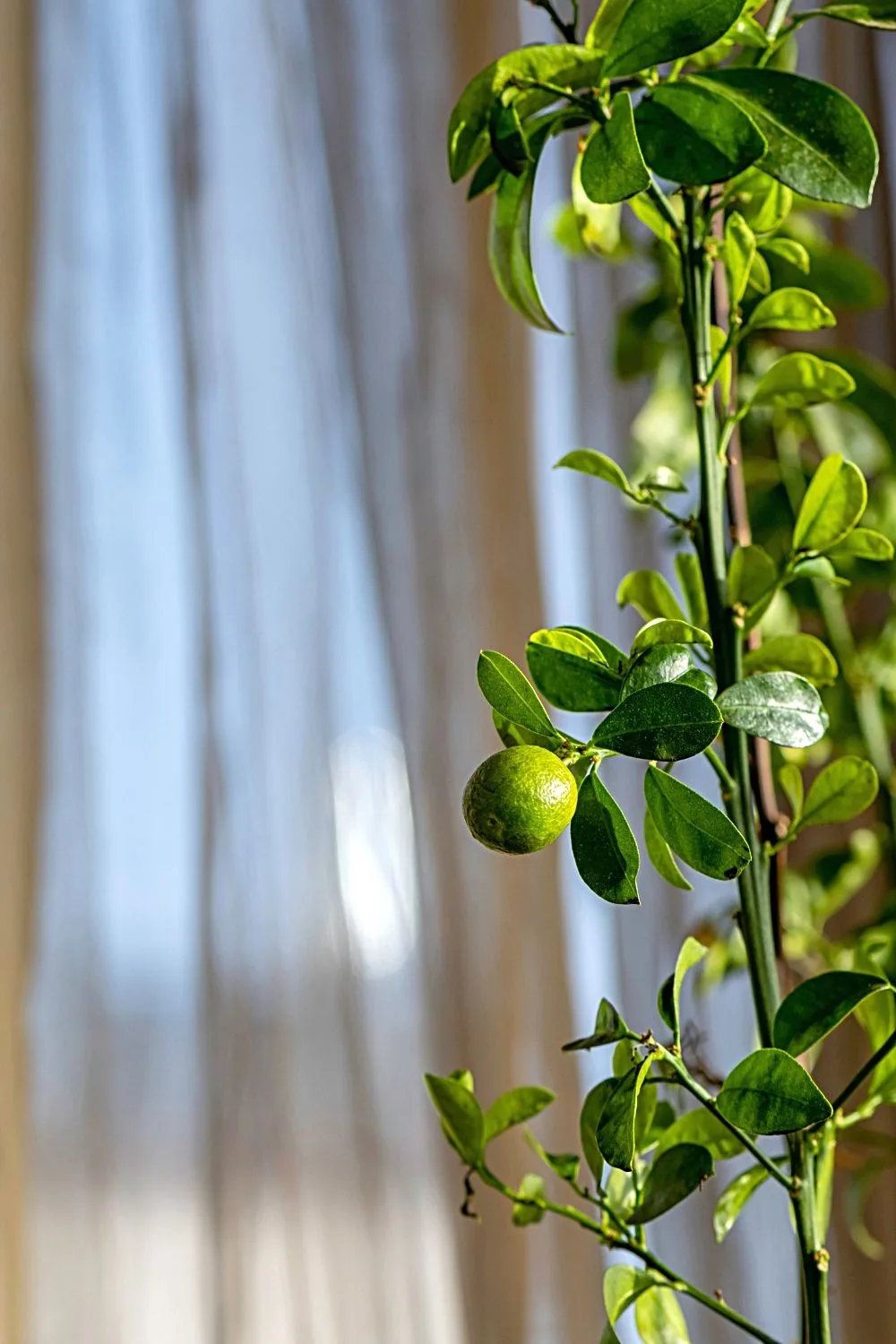
Dwarf Citrus is another great plant to grow by your southeast-facing window
A member of the Rutaceae family, the Dwarf citrus is another good option for southeast-facing windows. This plant has a pleasant fragrance oozing from its fruits and flowers.
It is actually a small tree that can bear limes, lemons, as well as oranges, depending on its species.
While it may seem tricky, growing them indoors is no tough job. Natives of the Asian tropical and subtropical regions, the plant enjoys bright sunlight for a minimum of six hours daily.
For a healthy plant, mist the leaves frequently.
- Scientific name: conifer tree (Thuja)
- Light requirements: moderate to high
- Watering requirements: low to moderate
- Growth rate: moderate
- Temperature: 28 degrees Fahrenheit and above
- pH: 6 to 7
- Care: low to moderate
6. String of Pearls

String of Pearls, with its long spherical and draped stems, is a great way of beautifying your southeast-facing window
An excellent addition to your houseplants will be the String of Pearls. This plant, botanically called Senecio rowleyanus, is a succulent that thrives in bright, filtered sunlight.
It has long spherical leaves with draped stems.
In the right conditions, they also produce blooms that are similar to a conglomerate of little white flowers with red stamens that shoot out of the outer edges. Moreover, they smell like cinnamon.
- Scientific name: Senecio rowleyanus
- Light requirements: moderate to high
- Watering requirements: low to moderate
- Growth rate: moderate
- Temperature: 68 to 70 degrees Fahrenheit
- pH: 6.6 to 7.5
- Care: low to moderate
7. African Milk Bush
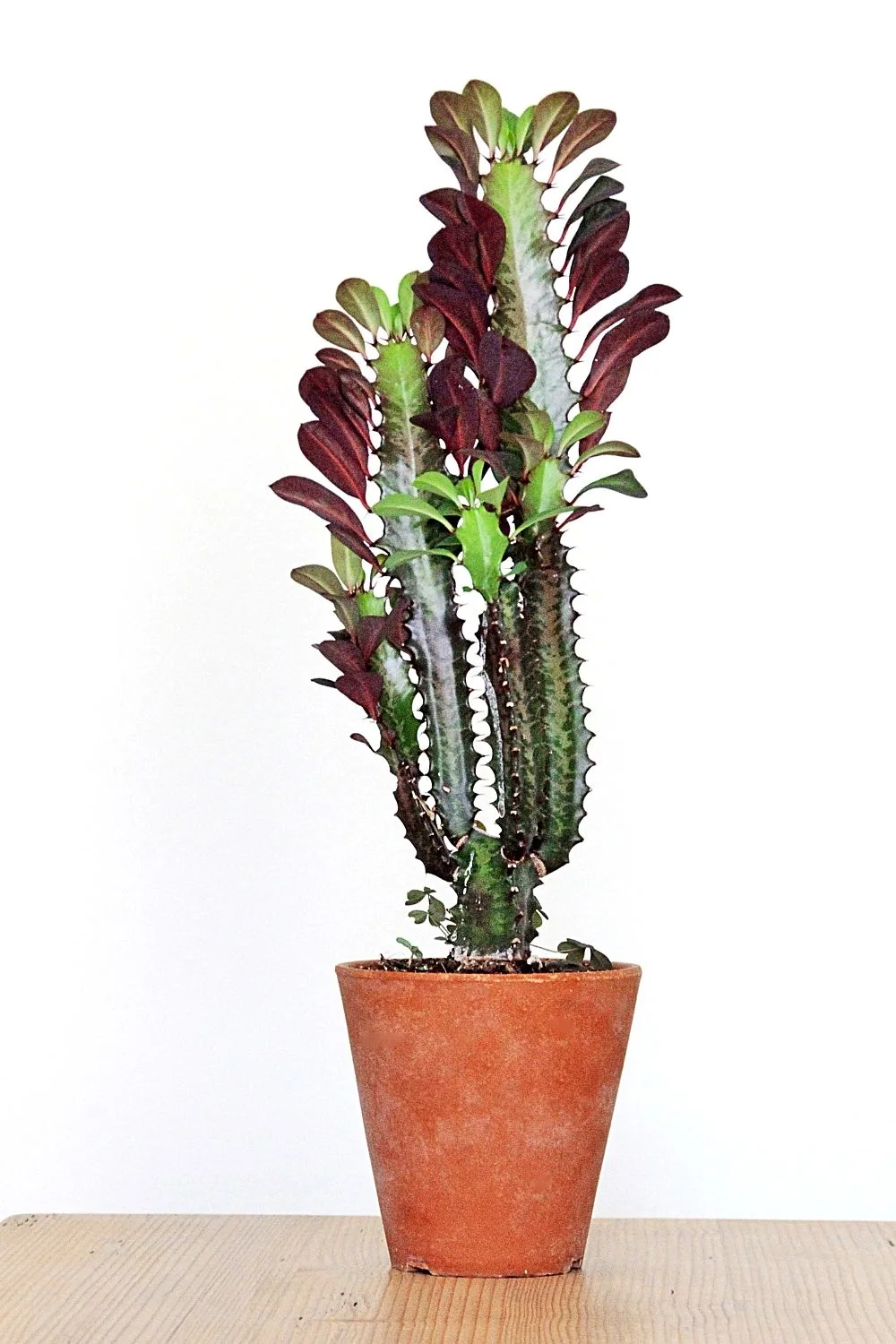
African Milk Bush is an ornamental shrub you can grow by your southeast-facing window
This one belongs to the Spurge family, also called Euphorbiaceae. They are herbs that are known as ornamental shrubs.
Under bright, dappled sunlight, the African milk bush gives rise to small yellow or white blooms.
Due to their lighting requirements, they should be placed in front of partially covered southeast-facing windows.
- Scientific name: Euphorbia trigona
- Light requirements: moderate to high
- Watering requirements: low to moderate
- Growth rate: moderate
- Temperature: 50 degrees Fahrenheit and above
- pH: 6.1 to 7.8
- Care: low to moderate
8. Ponytail Palm
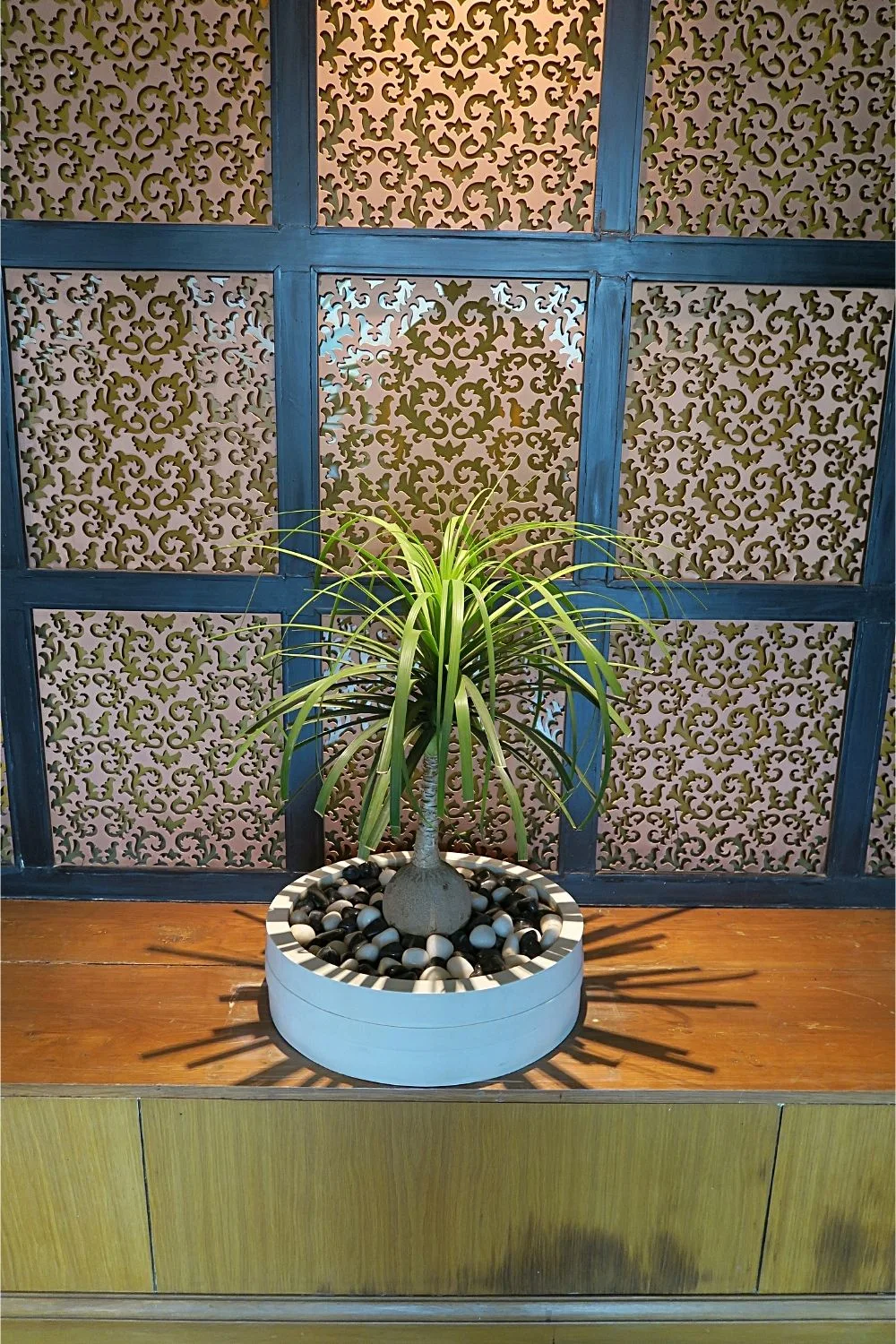
Ponytail Palm is actually a tree that you can grow by your southeast-facing window
This plant’s appearance is as interesting as its name. Also called Beaucarna recurvate, it’s actually a tree.
It has a very easy-care routine and lives on for several years without much attention.
Ponytail palm’s name comes from its slender, leathery leaves that sprout from a central and thick stem. The plant’s overall look can be likened to that of a horse’s tail.
Surprisingly, they aren’t even real palms. Natives of Mexico, they thrive in abundant sunlight.
- Scientific name: Beaucarna recurvate
- Light requirements: moderate to high
- Watering requirements: low to moderate
- Growth rate: moderate
- Temperature: 23 degrees Fahrenheit and over
- pH: 6.5 to 7.5
- Care: low to moderate
9. Areca Palm
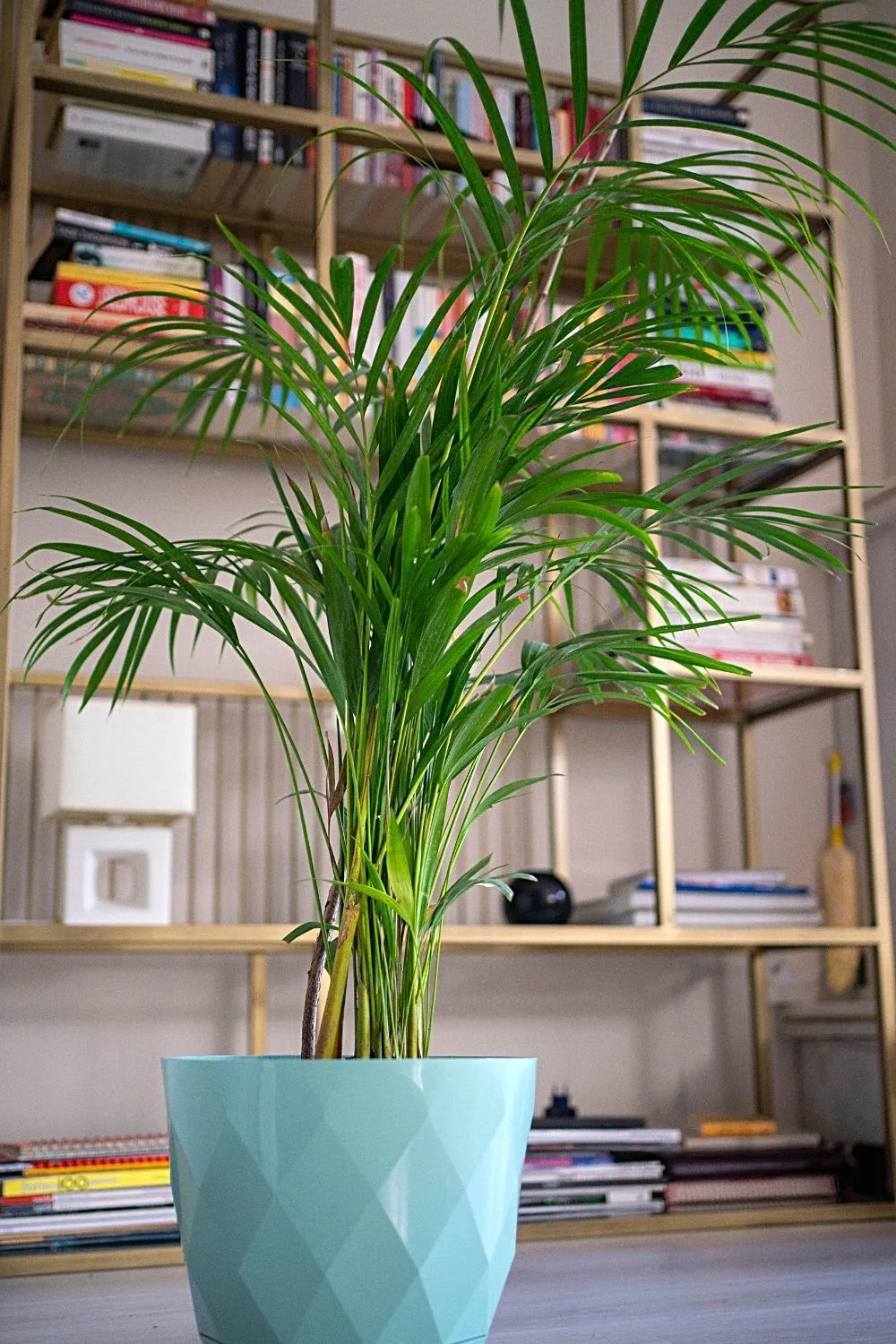
Areca Palm, with its feather-like fronds, is a great way of beautifying your southeast-facing window
Chrysalidocarpus lutescens or Areca palm is another excellent choice for southeast-facing windows. Plant enthusiasts adore their feather-like fronds, each having up to 100 leaflets.
These true palms are known for flourishing in humid and hot areas.
The Areca Palm naturally sprouts in Malaysia, Philippines, Pakistan, India, and Southeast Asia – all are hot regions – hence a high light level is needed.
Southeast and southwest-facing windows work great for these plants. However, do not leave them in such settings for too long as the fronds may fry.
- Scientific name: Chralidocarpus lutescens
- Light requirements: moderate to high
- Watering requirements: low to moderate
- Growth rate: moderate
- Temperature: 55 to 75 degrees Fahrenheit
- pH: 6.1 to 6.5
- Care: low to moderate
10. Jasmine
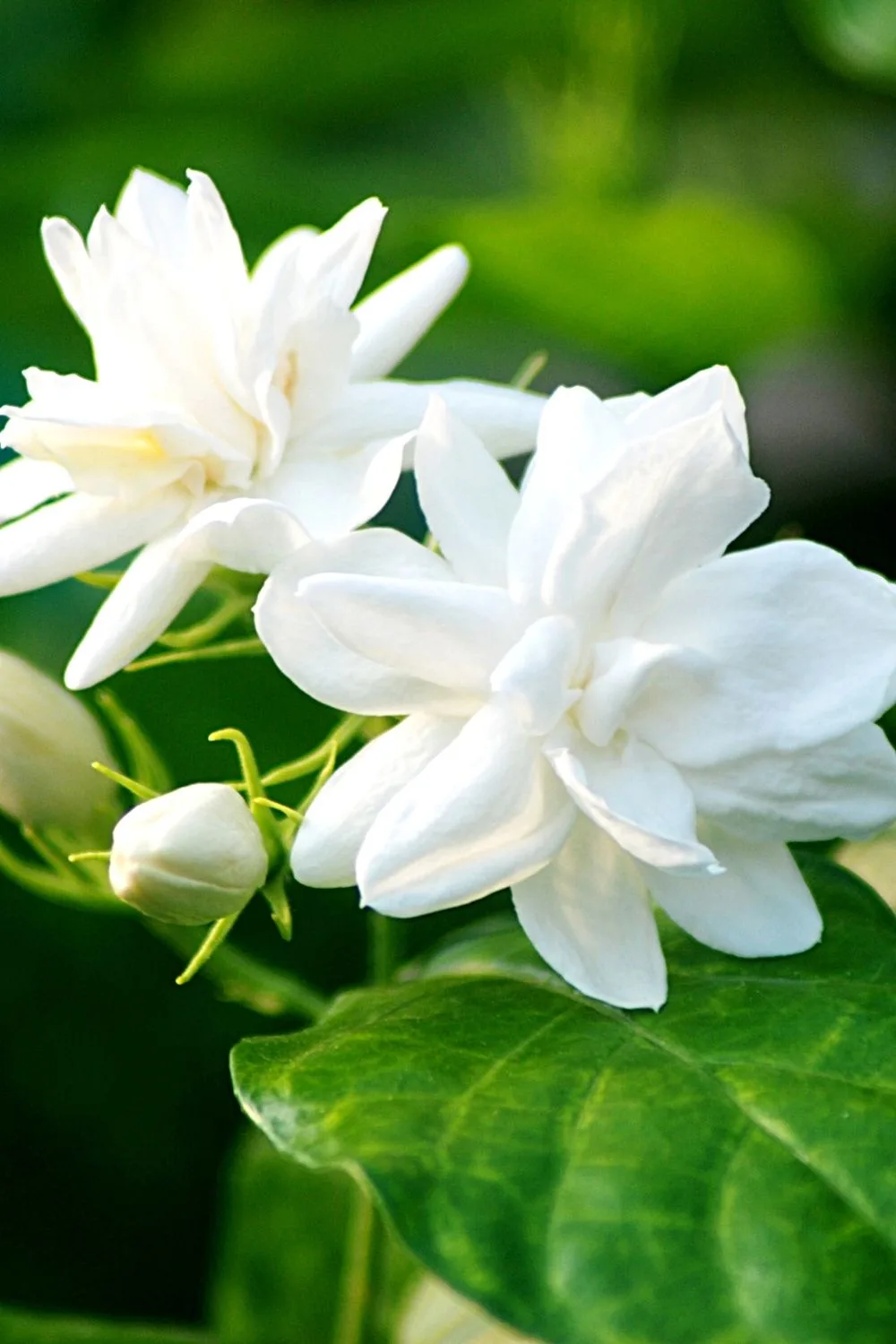
Jasmine’s fragrant white blooms are a great way of beautifying your southeast-facing window
Have your house smell like a garden with the jasmine plant. The jasmine plant requires bright, dappled sunlight, only then can it produce its popular fragrant blooms.
Naturally, this plant is found in tropical areas of Europe, Eurasia, and Australia, hence the high light level need.
The plant can survive low light levels, but for the healthiest growth, place it in bright, filtered sunlight coming through a southeast-facing window.
- Scientific name: Jasminum
- Light requirements: moderate to high
- Watering requirements: low to moderate
- Growth rate: moderate
- Temperature: 60-74 degrees Fahrenheit
- pH: 4.9 to 8.3
- Care: low to moderate
11. Geranium
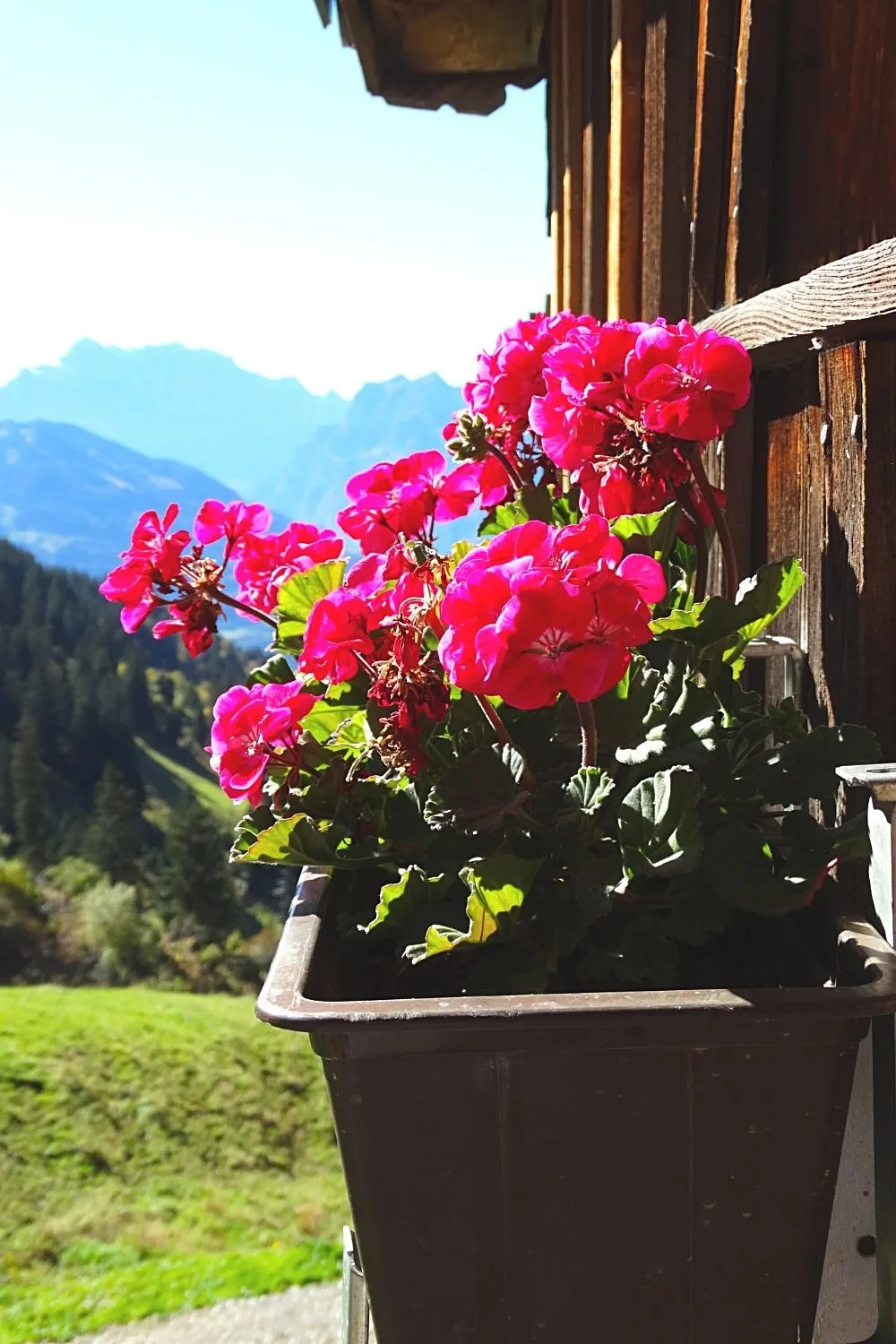
Geranium is a colorful plant you can grow by your southeast-facing window
Geranium is another great choice when looking for southeast-facing windows. With its violet vibrancy, it adds a colorful look to the dullest corners indoors.
Widely known for their lovely, large flowers, they are several houseplant owners’ favorites.
The Geranium blooms come in a multitude of colors, including pink, yellow, red, white, blue, and purple. With the Geranium plant and its blooms, you can very well create a home-made rainbow.
These South African herbs grow in tropical regions naturally; therefore, they should be placed where there’s plenty of sunlight and humidity.
Overall, they prefer full sunlight, except for Ivy Geranium which likes light shade.
- Scientific name: Pelargonium
- Light requirements: moderate to high
- Watering requirements: low to moderate
- Growth rate: moderate
- Temperature: 65 to 95 degrees Fahrenheit
- pH: 6 to 6.5
- Care: low to moderate
12. Sweet Basil

Sweet Basil is a great herb to grow by your southeast-facing window
Next up, we have sweet basil in the ideal plants for the southeast-facing windows plant category. This is a small herb that dominates most tropical forests of India.
It is a prominent member of the Lamiaceae family, also referred to as the Mint family.
Sweet basil has been around for several years due to its aromatic foliage. For the healthiest growth, it should be planted where there are six to eight hours of sunlight.
Anything less will lead to muted sweet basil plant.
- Scientific name: Ocimum basilicum
- Light requirements: moderate to high
- Watering requirements: low to moderate
- Growth rate: moderate
- Temperature: 50 to 80 degrees Fahrenheit
- pH: 6 to 7.5
- Care: low to moderate
13. Sago Palm
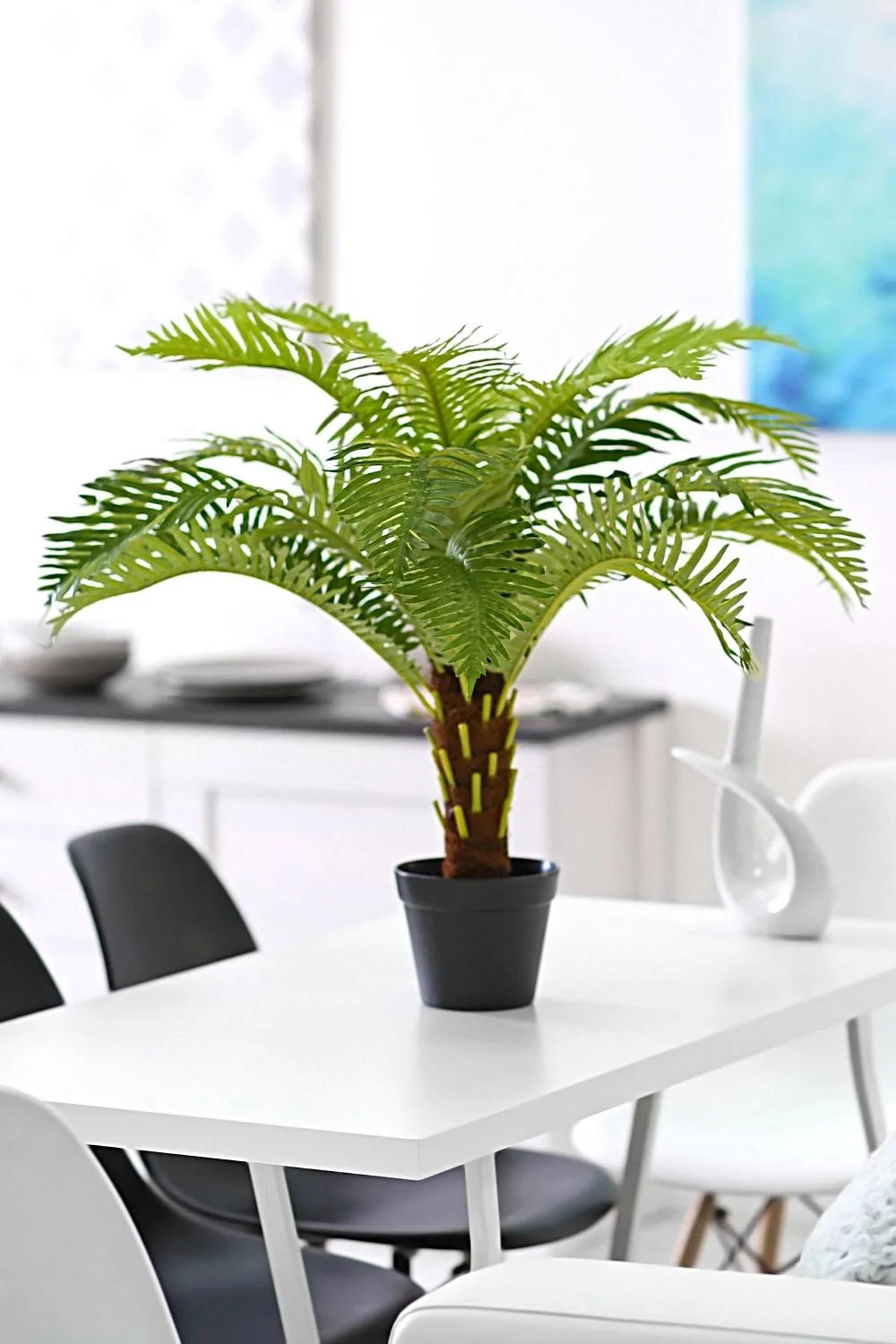
Sago Palm, a succulent that thrives in bright and dappled sunlight, thrives when placed by your southeast-facing window
Sago palm is another plant that thrives in bright, dappled sunlight. It is a succulent that grows with ease.
It is again an inhabitant of tropical regions, particularly growing in Oceania and Southeast Asia. Other than that, it springs up in swampy peat habitats mostly.
Brightly lit areas, as well as partially shaded spots, work well for the Sago plant.
- Scientific name: Cycas revoluta
- Light requirements: moderate to high
- Watering requirements: low to moderate
- Growth rate: moderate
- Temperature: 65 to 75 degrees Fahrenheit
- pH: 5.5 to 6.5
- Care: low to moderate
14. Money Plant
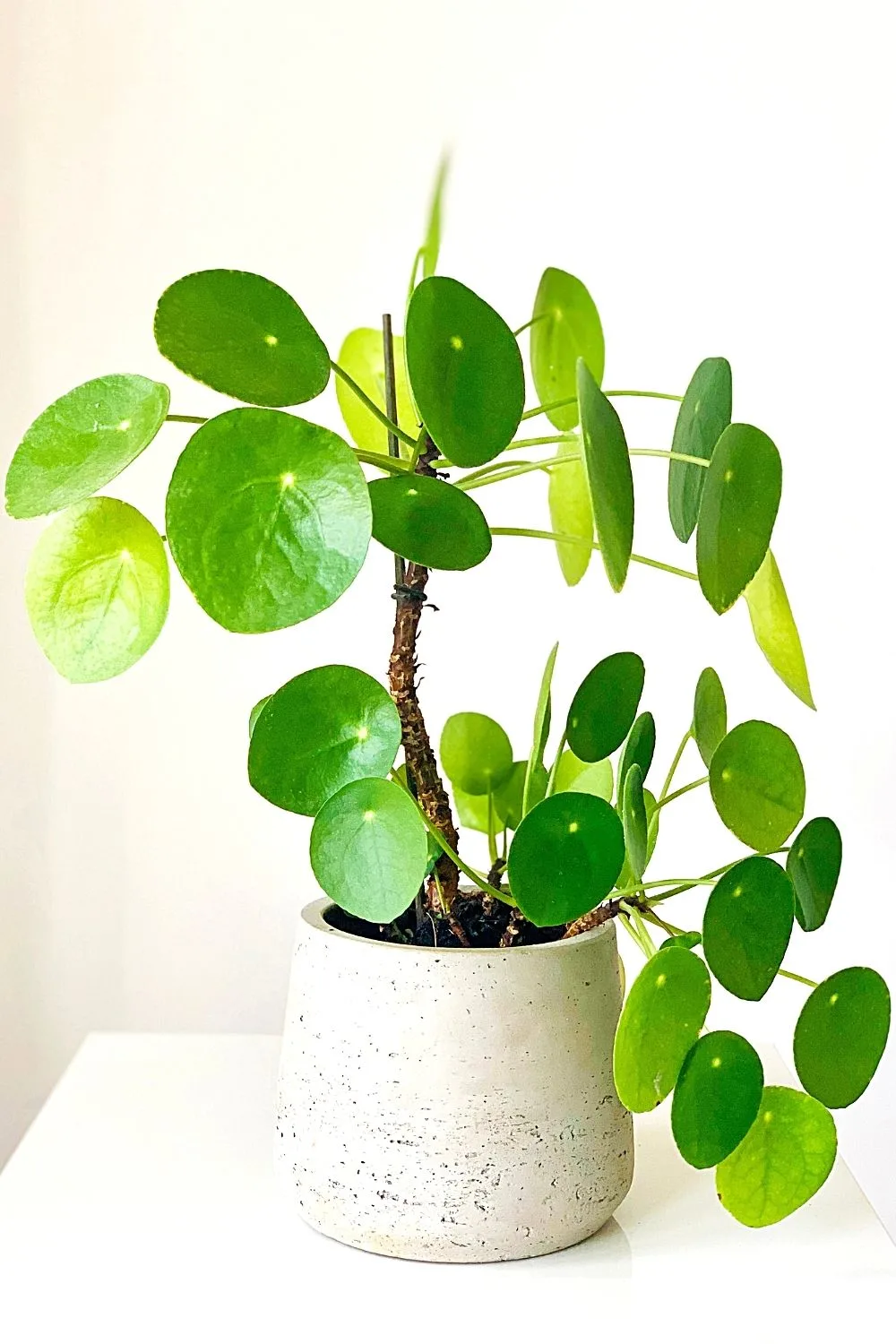
If you’re raring to grow a plant that signifies friendship and good luck, grow the Money Plant by your southeast-facing window
The money plant is among the most popular houseplants worldwide. It has round flat foliage that has a lush green color.
The plant is a native of southern China and is signified for friendship and good luck in feng shui practices.
The Money plant’s very easy to care and grow, even for beginners. Needing bright, indirect sunlight, it thrives under southeast-facing windows.
- Scientific name: Pilea peperomioides
- Light requirements: moderate to high
- Watering requirements: low to moderate
- Growth rate: moderate
- Temperature: 60 to 80 degrees Fahrenheit
- pH: 6 to 7
- Care: low to moderate
15. Bird of Paradise
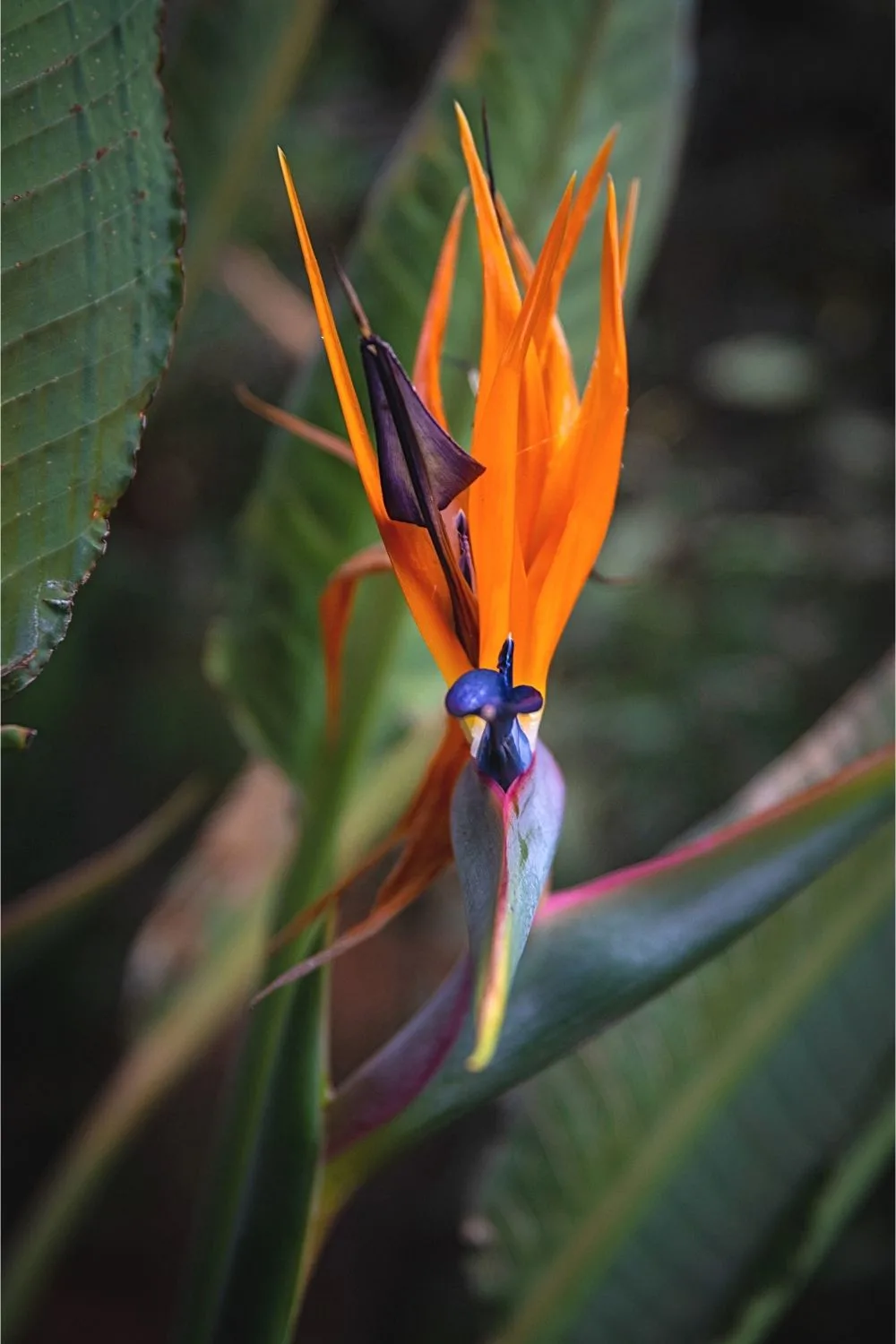
Bird of Paradise is a great tropical ornamental plant to spice up your southeast-facing window
This wonderful plant gets its name from its blooms, which resemble a bird species with a similar name.
The Bird of Paradise plant symbolizes joy, freedom, and as the name suggests, paradise. It makes a tropical ornamental centerpiece in any room it is placed in.
- Scientific name: Strelitzia nicolai
- Light requirements: moderate to high
- Watering requirements: low to moderate
- Growth rate: moderate
- Temperature: 65 to 70 degrees Fahrenheit
- pH: 6 to 7
- Care: low to moderate
16. String of Hearts
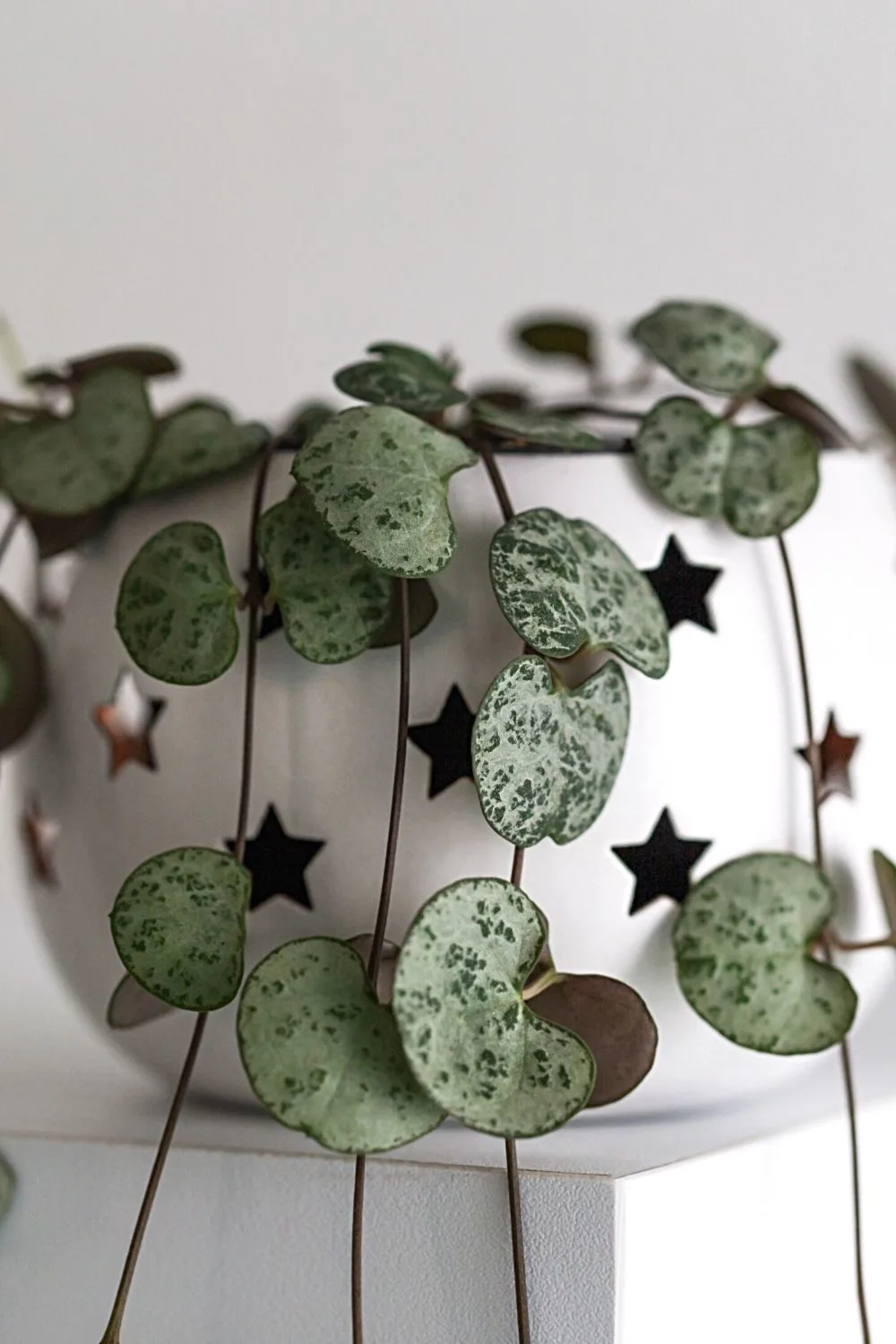
String of Hearts is known for its long vines and leaves that resemble hearts, hence, is a great addition to your southeast-facing window plant collection
Another beauty on this list is the String of hearts plant. It is popular for its attractive vines that resemble a long chain of hearts.
This South African variant has even been awarded for its charming appearance, earning it the 2017 Royal Horticulture Society’s Award of Garden Merit.
- Scientific name: Ceropegia woodii
- Light requirements: moderate to high
- Watering requirements: low to moderate
- Growth rate: moderate
- Temperature: 60 to 85 degrees Fahrenheit
- pH: 6 to 7
- Care: low to moderate
17. Citrus Trees

Citrus Trees is another great addition to your southeast-facing window if you’re raring to plant something edible indoors
Another tree on this list is the citrus tree. Citrus trees have recently gained more in popularity, reasonably so.
They are not much of a hassle and also earn you an abundant supply of fresh lemons and oranges. You can choose from Meyer lemon, calamondin orange, and kumquat trees.
- Scientific name: Citrus Trees (Meyer lemon, Calamondin orange, and Kumquat trees)
- Light requirements: moderate to high
- Watering requirements: low to moderate
- Growth rate: moderate
- Temperature: 65-73 degrees Fahrenheit
- pH: 6 to 7
- Care: low to moderate
18. Lavender
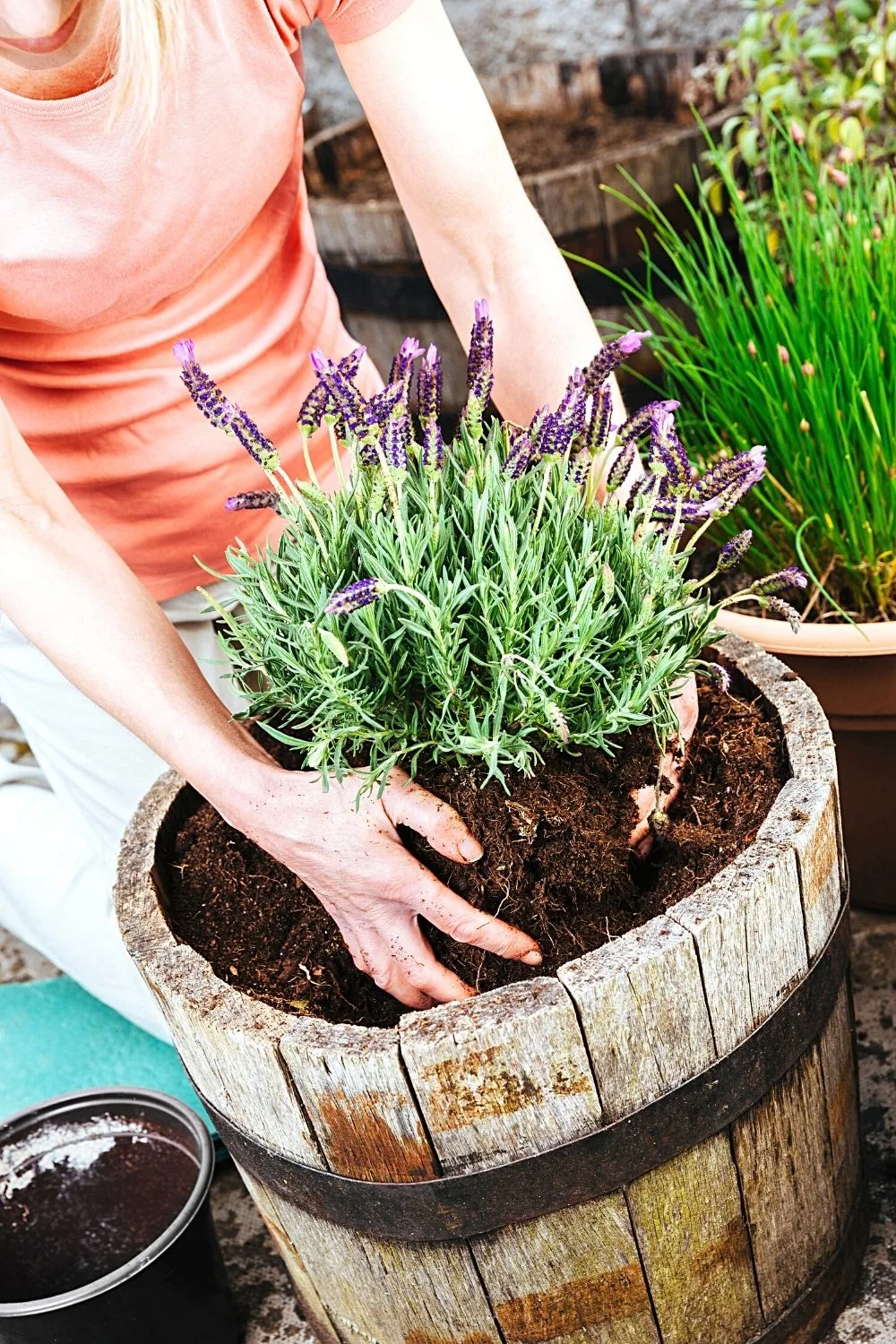
Lavender is an aromatic plant you can grow by your southeast-facing window
Bring home a lavender plant and place it in front of a southeast-facing window to have a natural touch to your house and have it smell good all day long.
Apart from reducing stress levels, lavender plant also purifies the air in your house.
This aromatic species is native to European lands, where it is used to make cosmetics, essential oils, and even food items. Lavender also symbolizes grace, peace, and serenity.
- Scientific name: Lavandula
- Light requirements: moderate to high
- Watering requirements: low to moderate
- Growth rate: moderate
- Temperature: 60 to 65 degrees Fahrenheit
- pH: 6.7 to 7.3
- Care: low to moderate
19. Kalanchoe
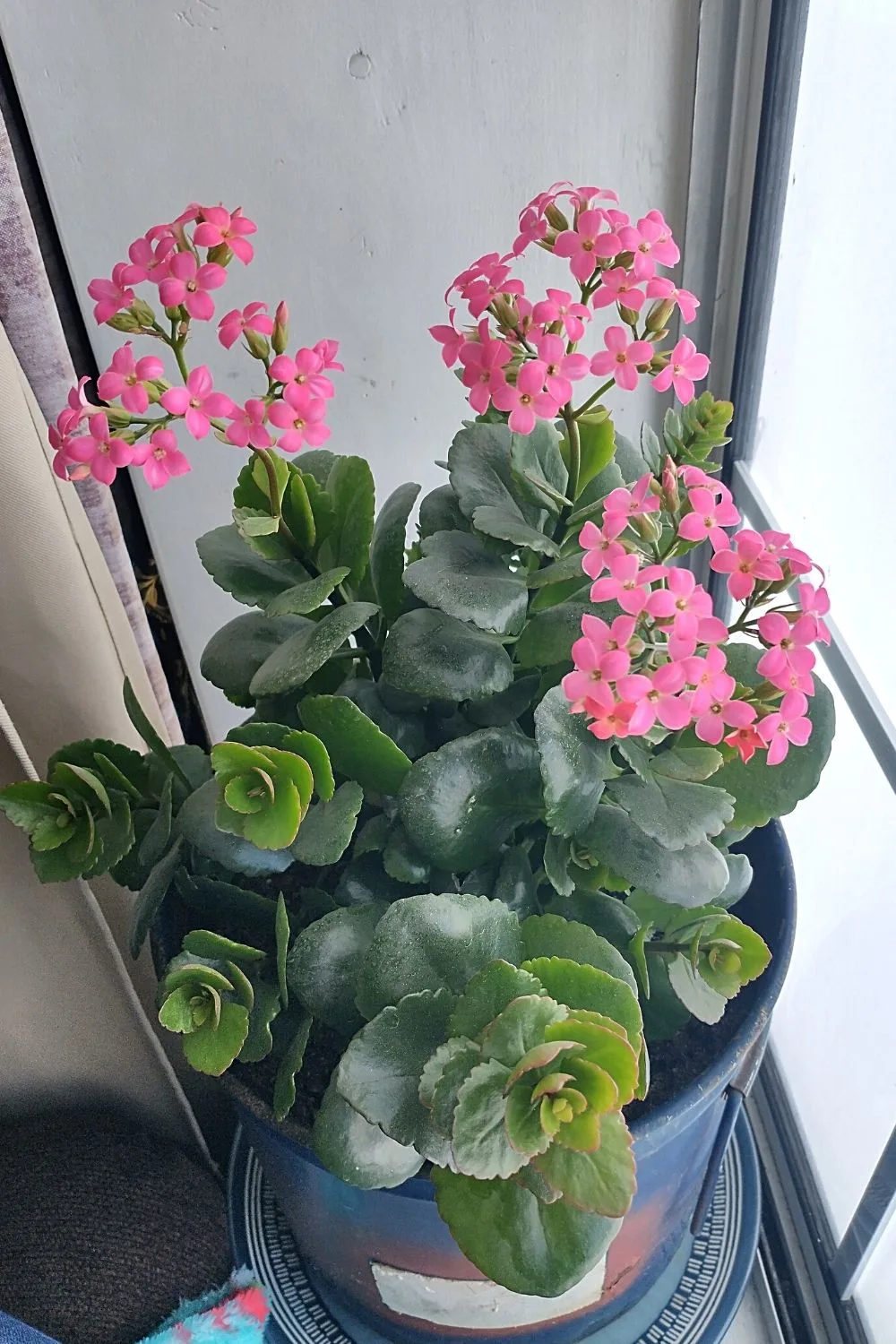
Kalanchoe is a flowering succulent that thrives in a southeast-facing window
A beautiful flowering succulent that you should add to your collection is the Kalanchoe. It is a native of parts of Madagascar and Africa; therefore, it greatly enjoys high light levels.
A fun fact about this species is that it was among the first ones to go into space on the Soviet Salyut space station.
- Scientific name: Kalanchoe
- Light requirements: moderate to high
- Watering requirements: low to moderate
- Growth rate: moderate
- Temperature: 65 to 85 degrees Fahrenheit
- pH: 5.8 to 6.3
- Care: low to moderate
20. Dracaena Fragrans
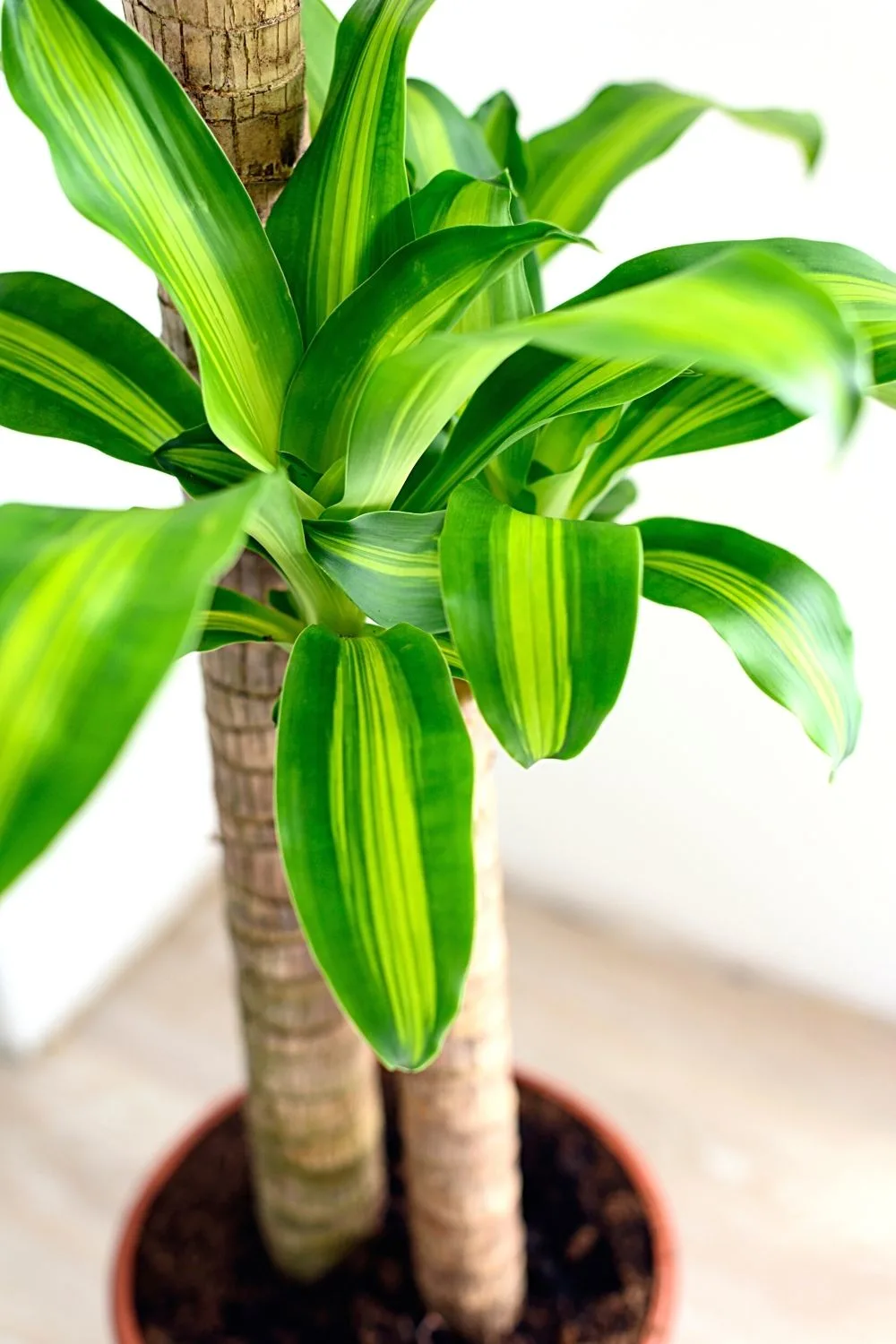
Dracaena Fragrans is another beautiful plant you can grow by your southeast-facing window
The Dracaena Fragrans plant is another beauty that you bring home. A native of the African continent, it is a flowering species with variegated leaves.
It is called corn plant and was again a part of an official mission, NASA’s Clean Air Study.
- Scientific name: Dracaena fragrans
- Light requirements: moderate to high
- Watering requirements: low to moderate
- Growth rate: moderate
- Temperature: 60-74 degrees Fahrenheit
- pH: 6 to 6.5
- Care: low to moderate
21. Anthurium
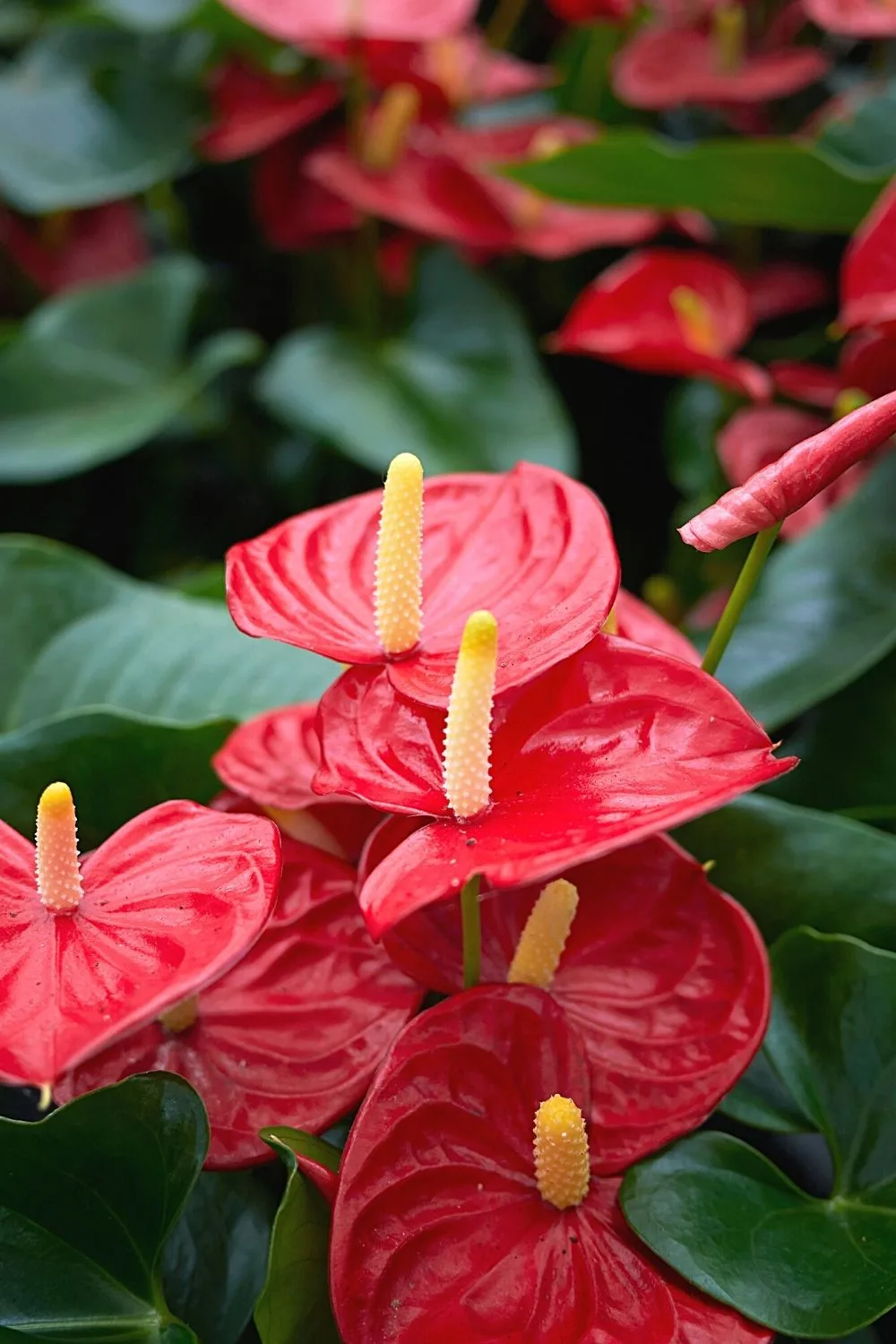
Anthurium is a bright plant that can liven up a southeast-facing window
An American native, Anthurium gives rise to bright red, white, and pink blooms or spathes with bright green pointy ends.
To add a bold look to a corner, plant an anthurium.
- Scientific name: Anthurium
- Light requirements: moderate to high
- Watering requirements: low to moderate
- Growth rate: moderate
- Temperature: 70 to 90 degrees Fahrenheit
- pH: 5.5 to 6.5
- Care: low to moderate
22. Fiddle Leaf Fig
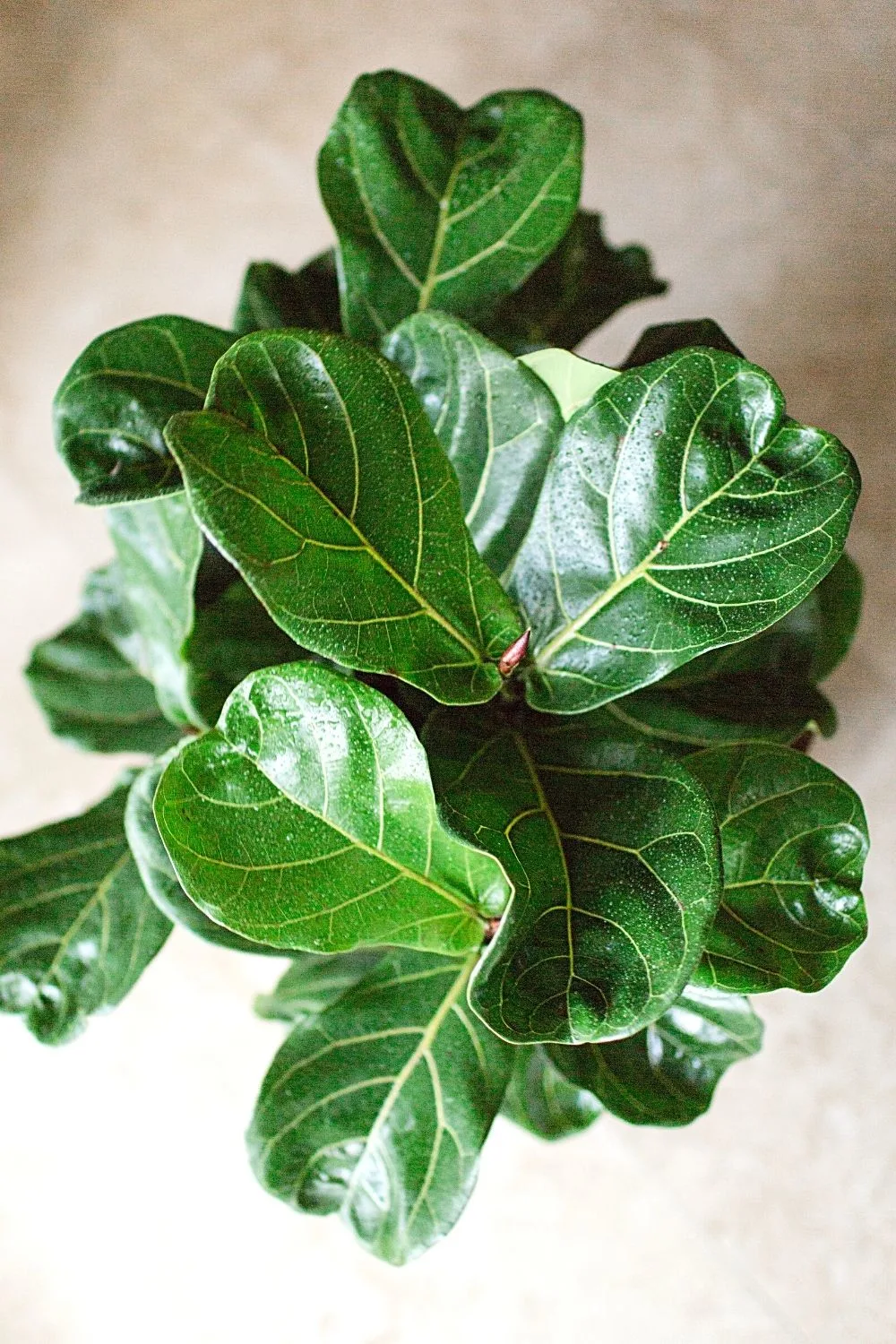
Fiddle Leaf Fig, despite its finicky nature, is a popular houseplant to be grown by a southeast-facing window
This plant is adored by several houseplant owners, despite its slightly finicky nature. This tree naturally grows in western Africa but has now spread worldwide.
It is quite picky about temperature, moisture, and sunlight.
When mature, the plant develops deep green showy leaves that add drama and texture to the space. Place it in front of a southeast-facing window to help it grow fully.
- Scientific name: Ficus lyrata
- Light requirements: moderate to high
- Watering requirements: low to moderate
- Growth rate: moderate
- Temperature: 60-73 degrees Fahrenheit
- pH: 6 to 7
- Care: low to moderate
23. Ficus Audrey
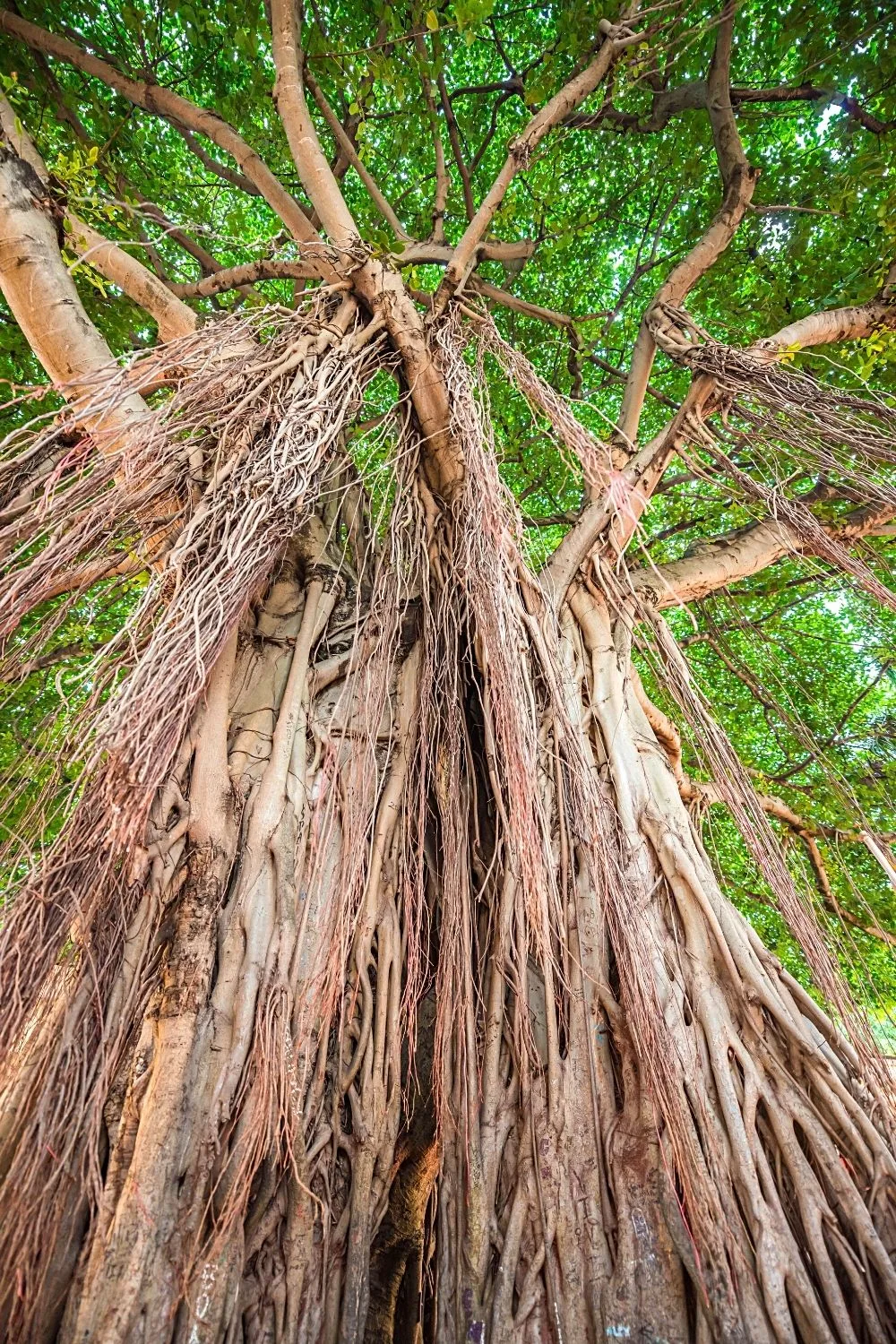
Ficus Audrey, despite being a large tree when grown outdoors, is easier to care for when grown indoors by a south-facing window compared to the Fiddle Leaf Fig
Next in this list we have Ficus Audrey, botanically called Ficus benghalensis. Some people also refer to it as Indian Banya, as it is the national tree of India.
Ficus Audrey has one the largest canopy coverage among all trees. Indoors, the Ficus benghalensis grows much easier than its cousin, fiddle leaf fig.
Place it in front of a southeast-facing window to meet its lighting requirements.
- Scientific name: Ficus benghalensis
- Light requirements: moderate to high
- Watering requirements: low to moderate
- Growth rate: moderate
- Temperature: 70 to 80 degrees Fahrenheit
- pH: 6 to 7
- Care: low to moderate
24. Pencil Cactus
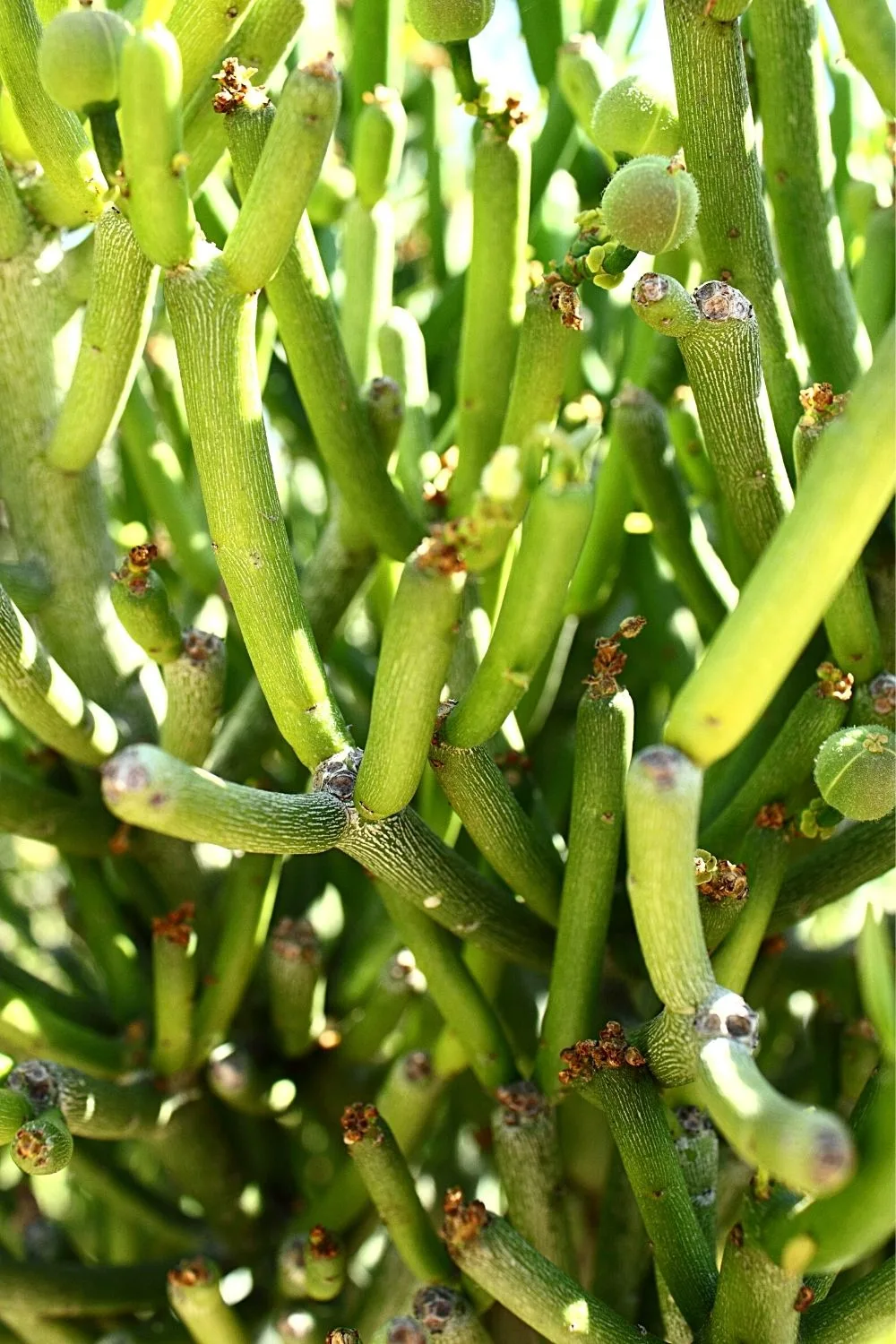
Pencil Cactus, despite being as thin as a pencil, can withstand unfavorable conditions longer and can thrive when grown by a southeast-facing window
The pencil cactus is quite literally as thin as a pencil; however, it is a lot stronger and can withstand unfavorable conditions for a considerable amount of time.
A native of the African lands, the pencil cactus has thin green branches that are initially pink.
Although it looks classic, the plant is poisonous to humans and pets. It may cause temporary blindness if even a small amount of the sap gets into contact with your eyes.
Please remember to place it at a height, so it is out of the reach of children and pets.
- Scientific name: Euphorbia tirucalli
- Light requirements: moderate to high
- Watering requirements: low to moderate
- Growth rate: moderate
- Temperature: 65 to 75 degrees Fahrenheit
- pH: 5.5 to 6.5
- Care: low to moderate
25. Prayer Plants

Prayer Plants are slow-growing plants that thrive when placed by a southeast-facing window
The Prayer plant, botanically known as Maranta Leuconeura, is a delight to grow. It is a slow-grower; therefore, it does not need regular checking or pruning.
Indoors, it reaches a height of about 1 foot (12 inches).
It thrives in partial shade to full light. The latter is slightly risky as anything too intense may scorch the leaves.
Therefore, ensure you rotate the plant every few days when placing it in front of a southeast-facing window.
Water it frequently as the light can cause dehydration. Moreover, provide it with warm and moist air and good-quality fertilizer for the healthiest growth.
- Scientific name: Maranta Leuconeura
- Light requirements: moderate to high
- Watering requirements: low to moderate
- Growth rate: slow
- Temperature: 59 degrees Fahrenheit and above
- pH: 5.5 to 6
- Care: low to moderate
26. Umbrella Tree

Umbrella Tree, with its shiny and long foliage, spruces up a southeast-facing window
The Umbrella tree, botanically known as the Schefflera, is another great addition to southeast-facing window plants’ list.
It has long, shiny foliage that meets at the main stalk, forming a pattern of an umbrella.
It likes bright, filtered sunlight throughout the day. If put in insufficient sunlight, the plant begins to wilt.
Please remember to mist the plant every other day and keep it away from direct drafts of wind from air conditioners and heaters.
- Scientific name: Schefflera
- Light requirements: moderate to high
- Watering requirements: low to moderate
- Growth rate: moderate
- Temperature: 65 to 90 degrees Fahrenheit
- pH: 6 to 6.5
- Care: low to moderate
27. Goldfish Plant
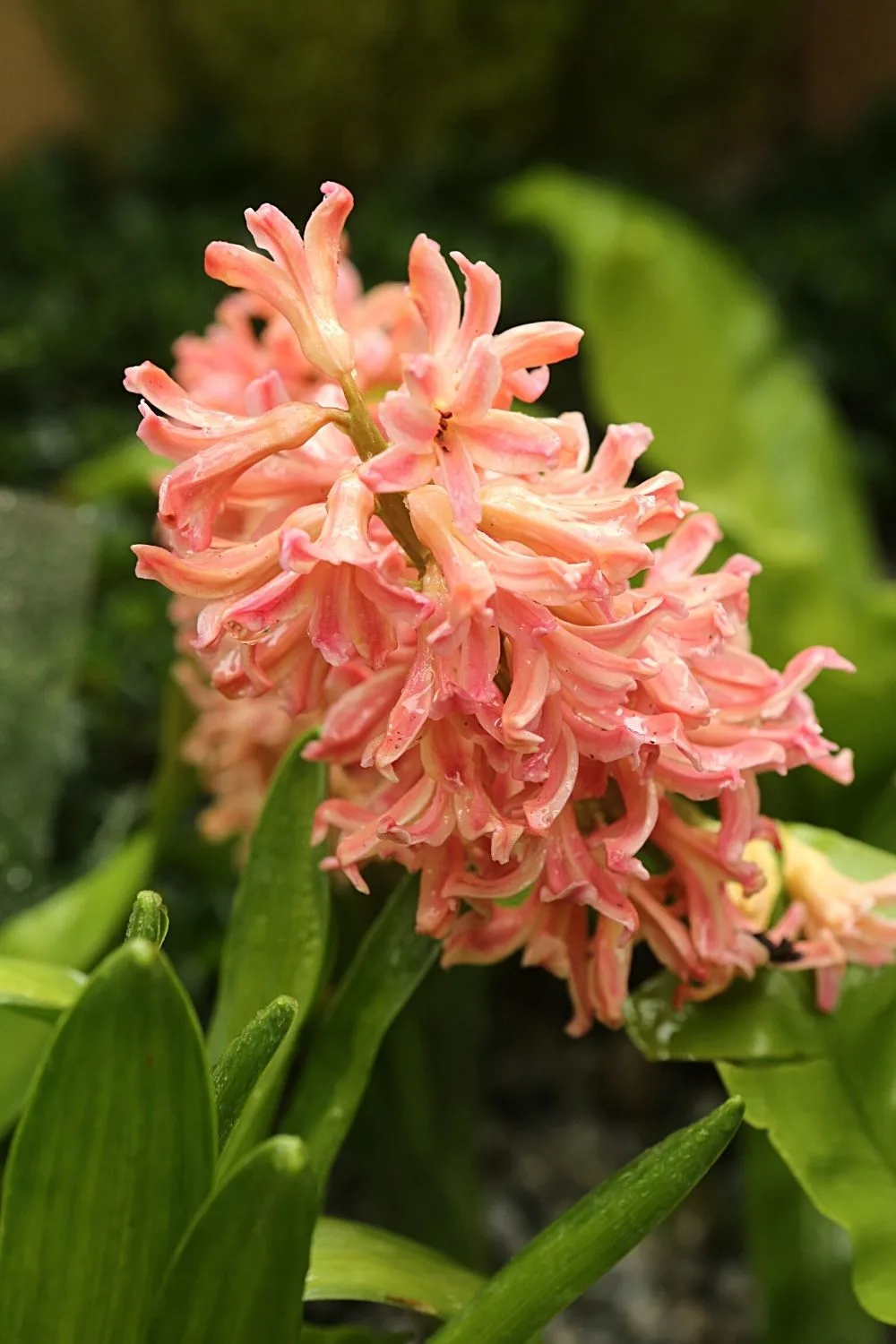
Goldfish Plant is another vibrant plant that you can grow by a southeast-facing window
The Columnea Gloriosa or Goldish plant is an excellent choice for southeast windows.
It has glorious red-orange blooms that fill a space with color and vibrancy.
- Scientific name: Columnea Gloriosa
- Light requirements: moderate to high
- Watering requirements: low to moderate
- Growth rate: moderate
- Temperature: 65 to 75 degrees Fahrenheit
- pH: 6.1 to 7.3
- Care: low to moderate
28. Paddle Plant
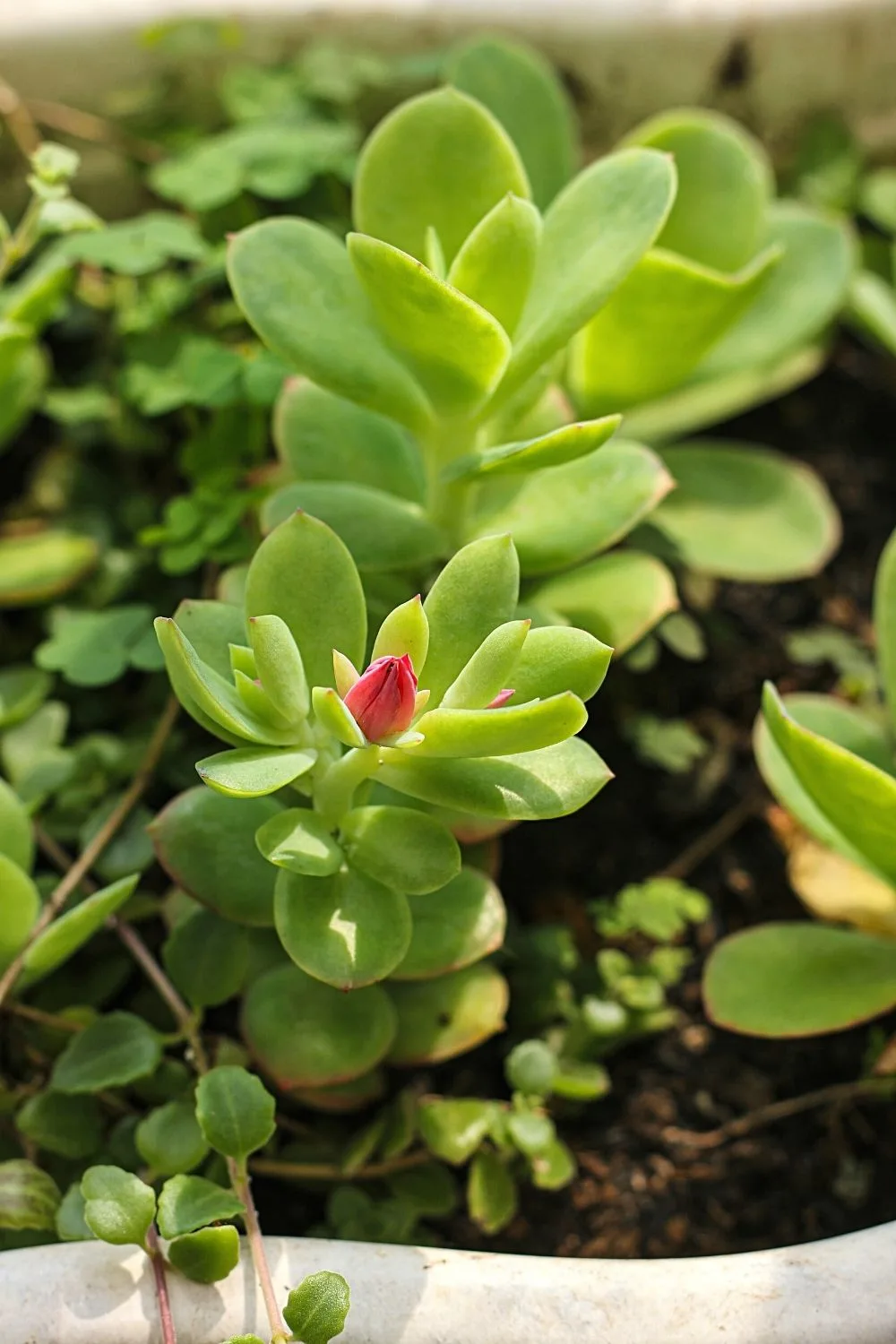
Paddle Plant, with its big, round leaves, is a great plant to grow by a southeast-facing window
Add paddle plant to your collection for a bold statement.
It has round, big leaves that enjoy bright, indirect sunlight from southeast-facing windows.
- Scientific name: Florist Kalanchoe
- Light requirements: moderate to high
- Watering requirements: low to moderate
- Growth rate: moderate
- Temperature: 60 to 85 degrees Fahrenheit
- pH: 6.1 to 7.8
- Care: low to moderate
29. Lady Palm
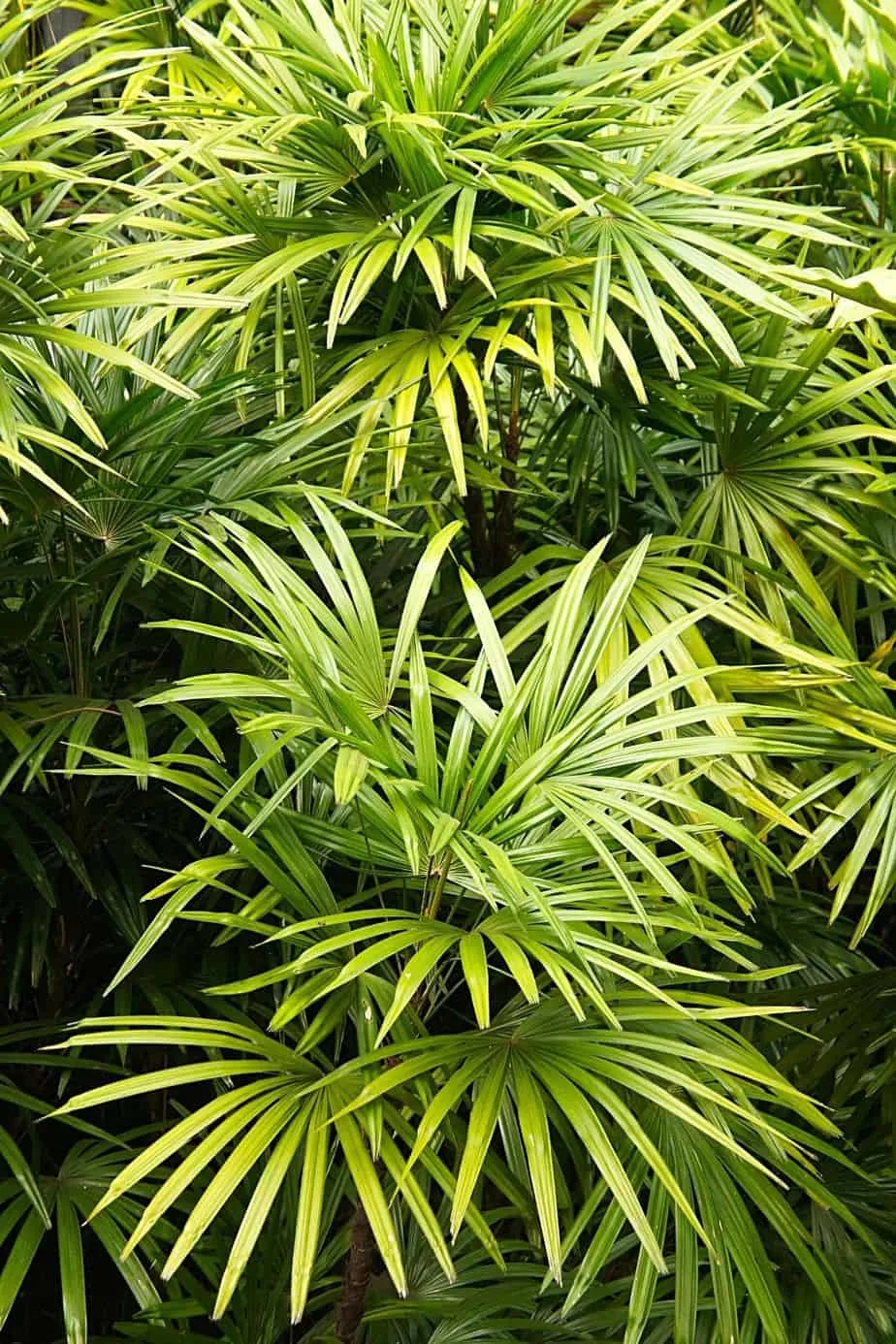
Lady Palm, with its long, slender leaves, is another great addition to beautify a southeast-facing window
Bring home the lady palm plant if you’re a fan of long, slender leaves.
This one likes filtered sunlight and occasional watering.
- Scientific name: Rhapis excelsa
- Light requirements: moderate to high
- Watering requirements: low to moderate
- Growth rate: moderate
- Temperature: 60 to 80 degrees Fahrenheit
- pH: 5.5 to 7
- Care: low to moderate
30. Bulb Albuca Namaquensis
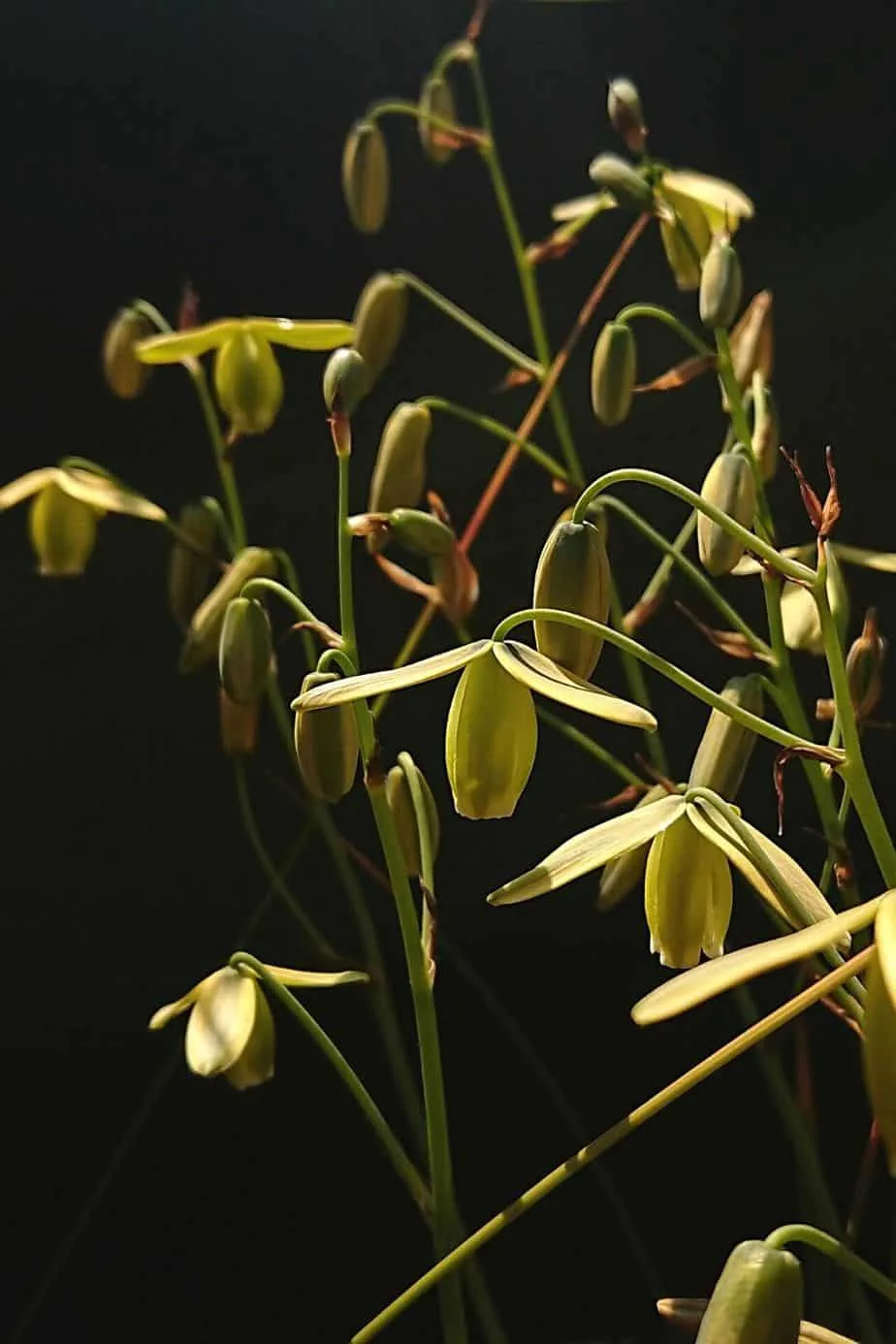
If you’re looking for a vanilla-like smelling plant, then the Bulb Albuca Namaquensis is a great plant to grow by your southeast-facing window
A highly unique plant is the Bulb Albuca Namaquensis.
It’s a very manageable plant and also has a vanilla-like scent.
- Scientific name: Albuca spiralis
- Light requirements: moderate to high
- Watering requirements: low to moderate
- Growth rate: moderate
- Temperature: 60 F
- pH: 6 to 7
- Care: low to moderate
Read about the top neon houseplant next.

Daniel has been a plant enthusiast for over 20 years. He owns hundreds of houseplants and prepares for the chili growing seasons yearly with great anticipation. His favorite plants are plant species in the Araceae family, such as Monstera, Philodendron, and Anthurium. He also loves gardening and is growing hot peppers, tomatoes, and many more vegetables.

![30 Houseplants for Southeast-Facing Window – Best Of [2024]](https://plantophiles.com/wp-content/uploads/2022/04/30-Houseplants-for-Southeast-Facing-Windows-720x405.jpg.webp)
